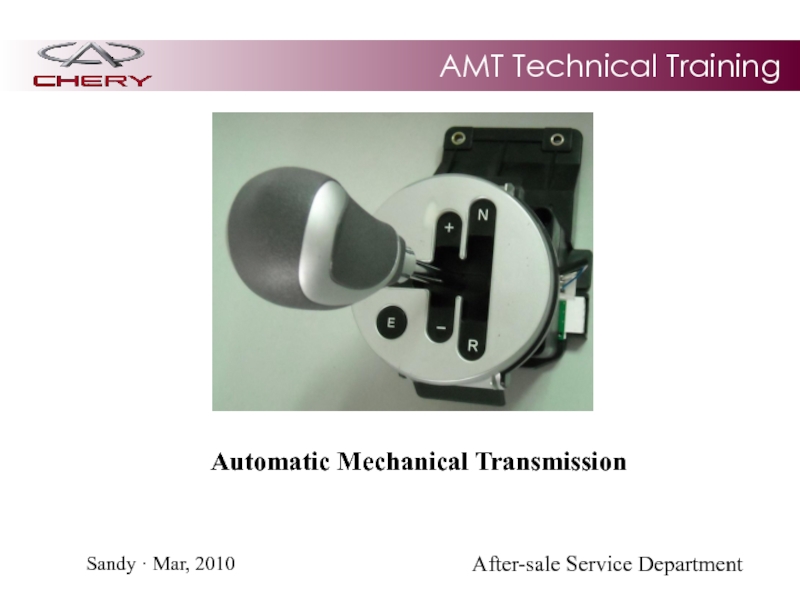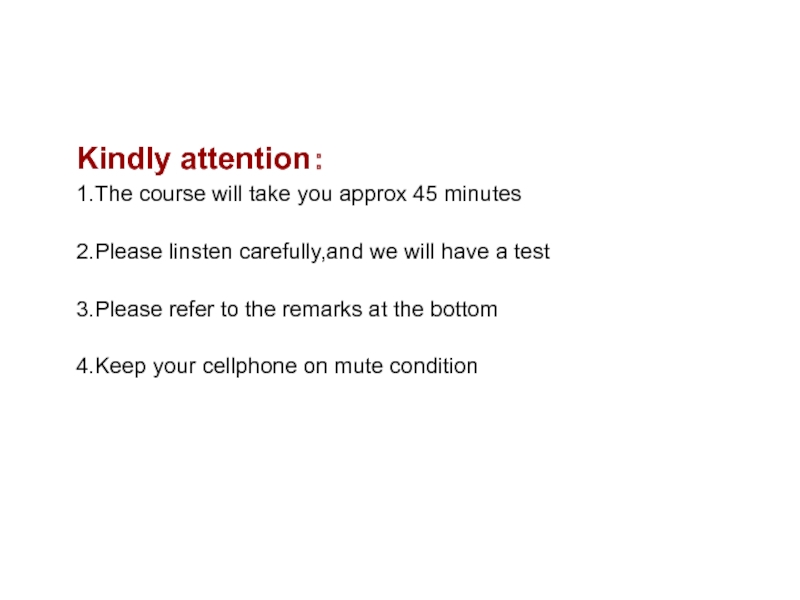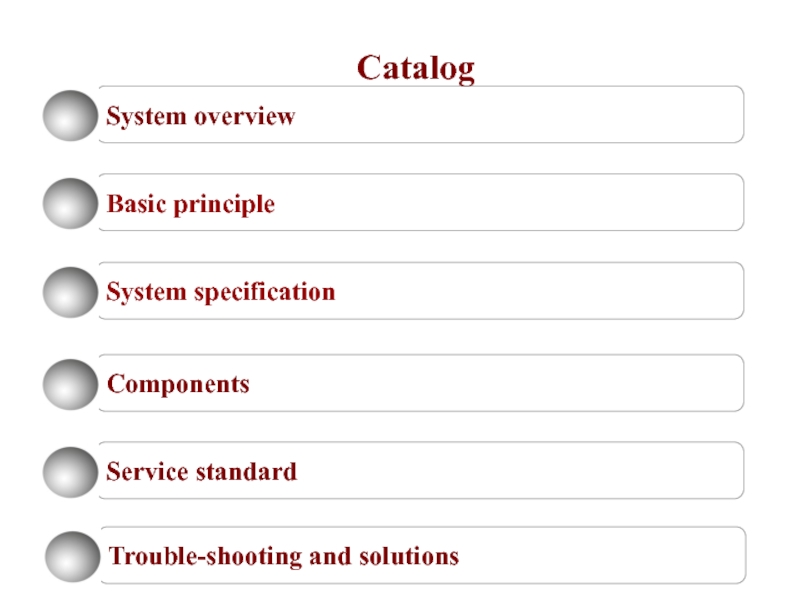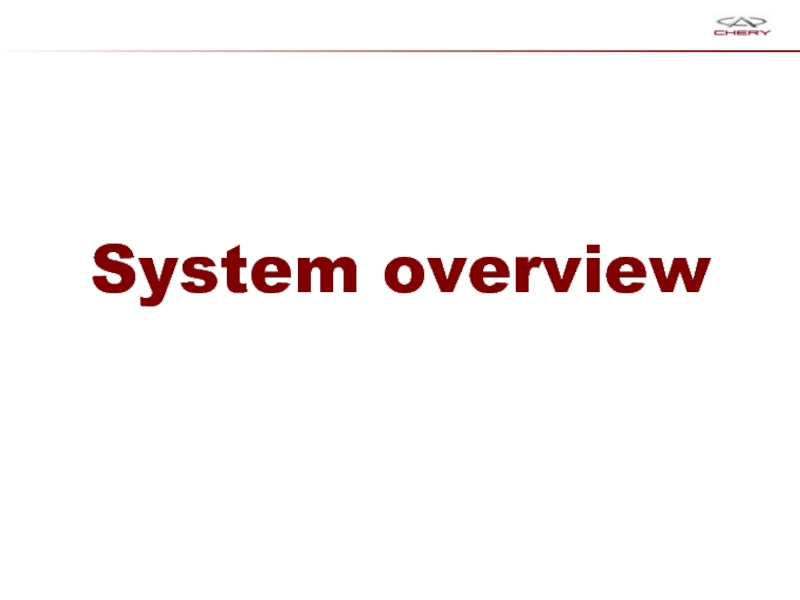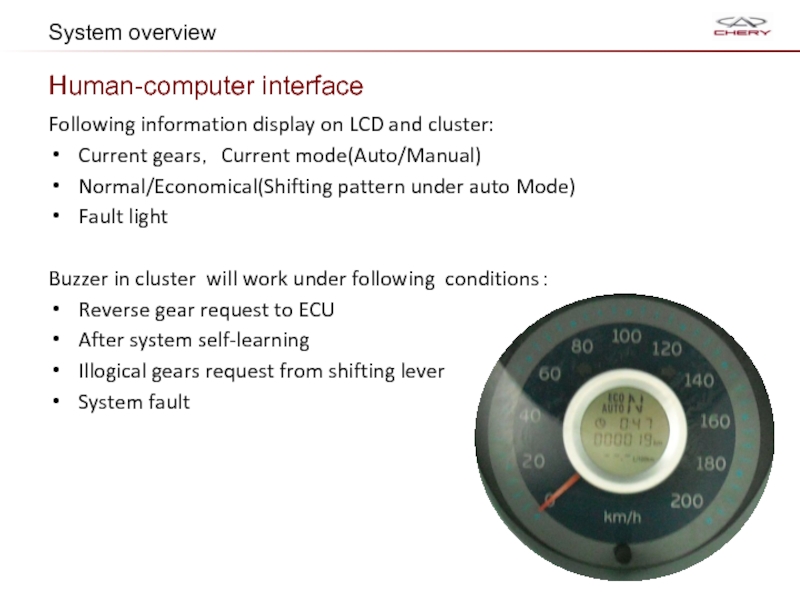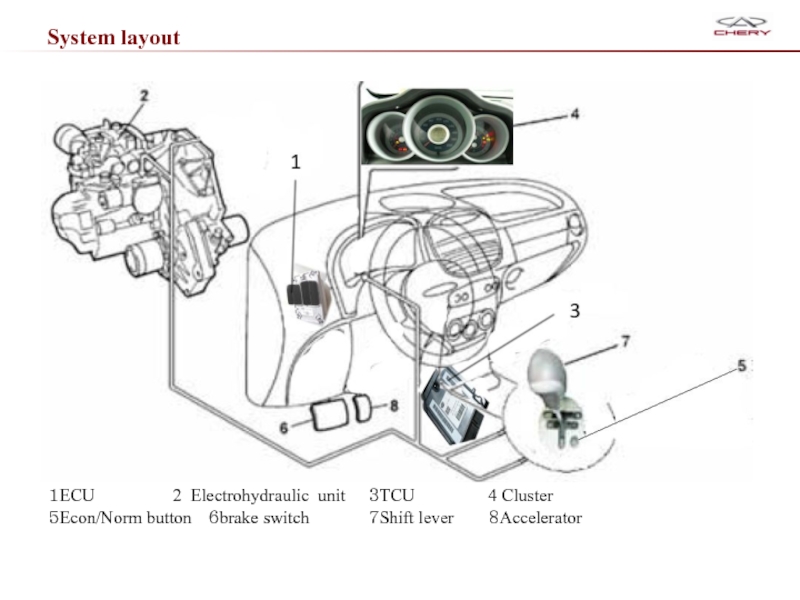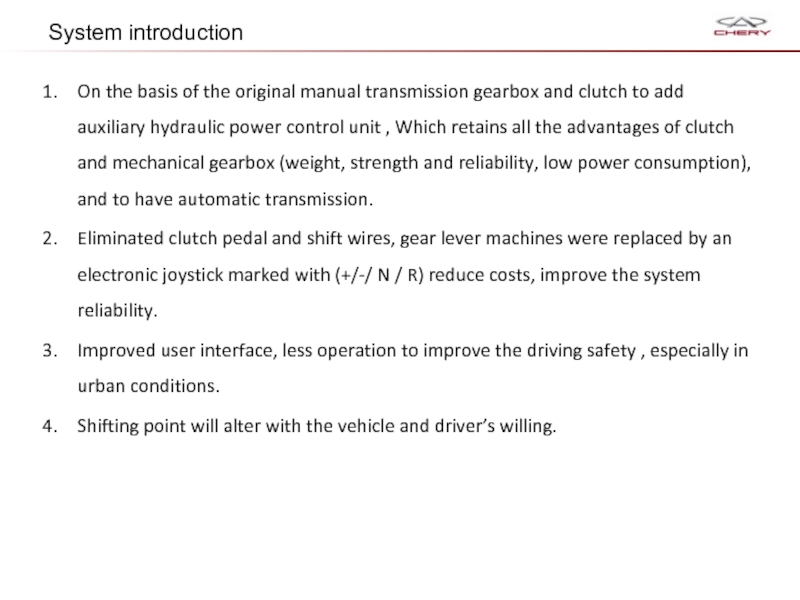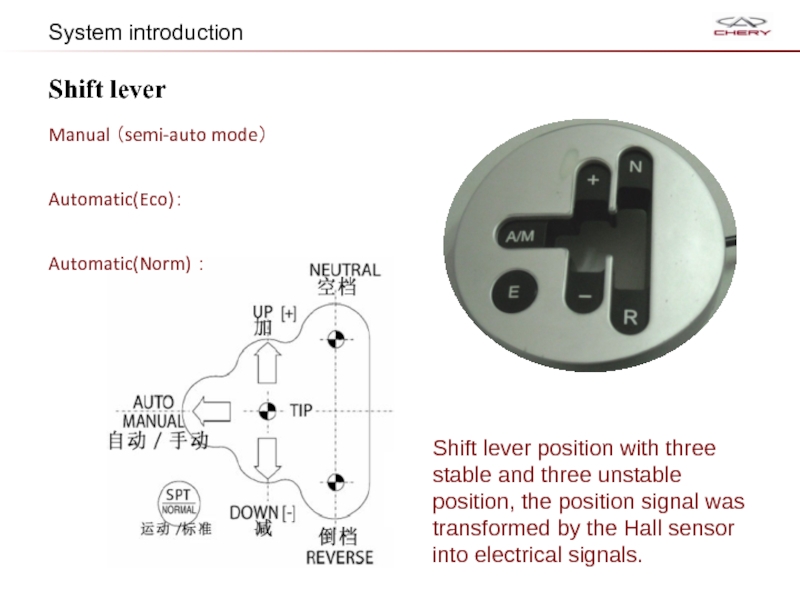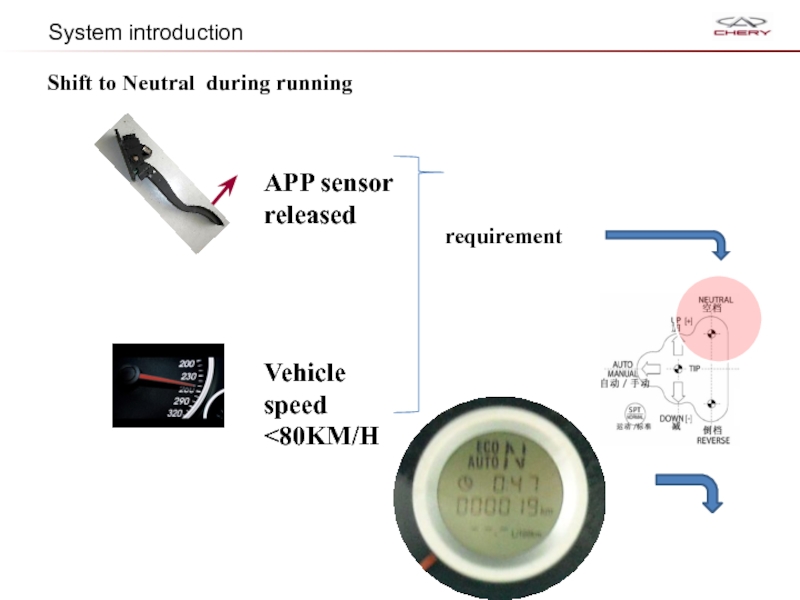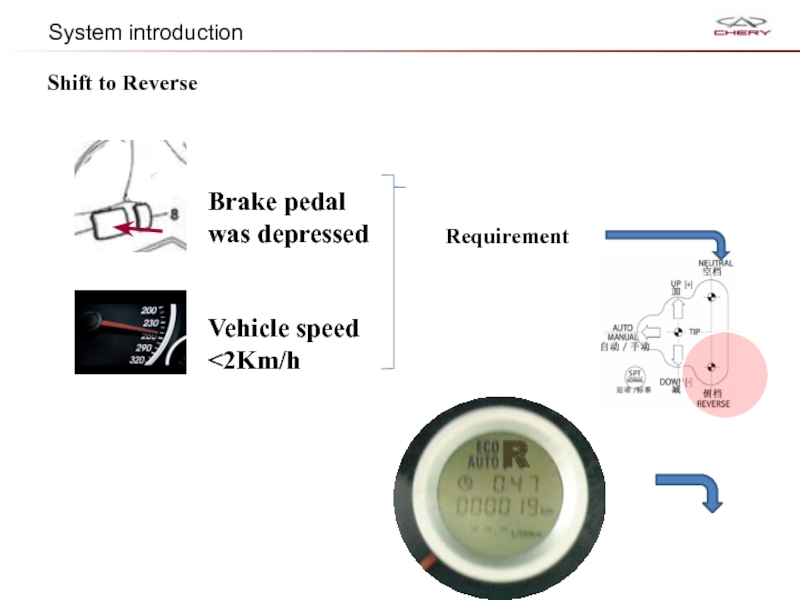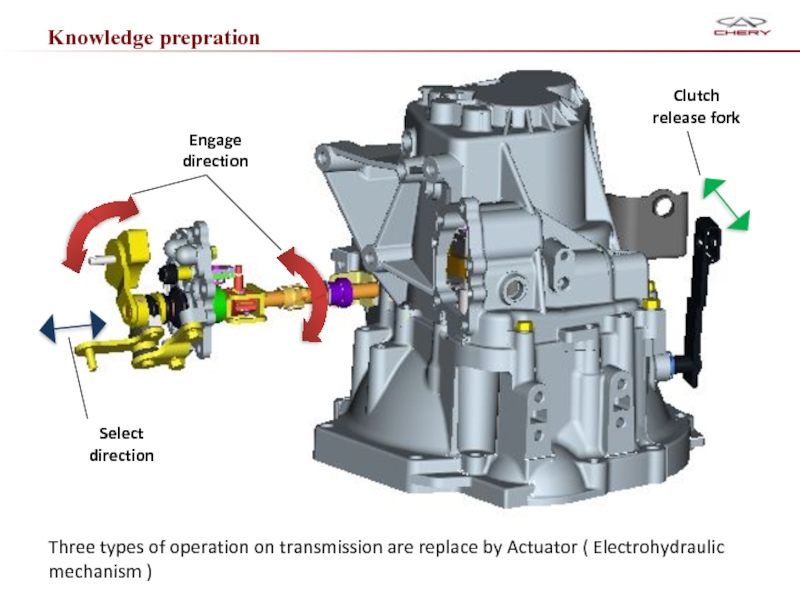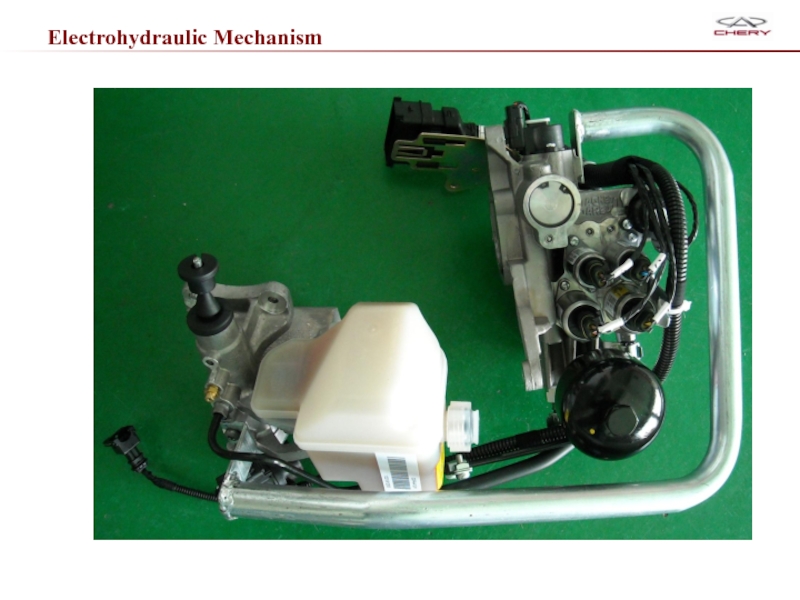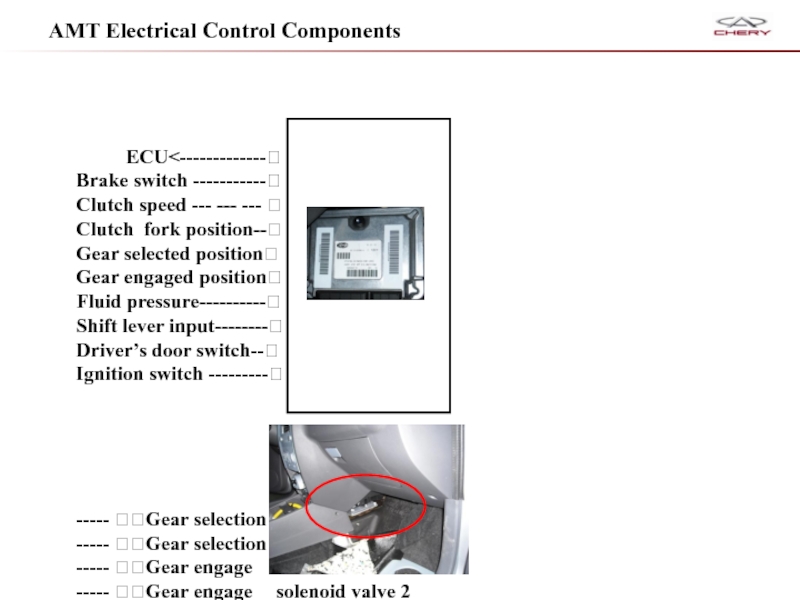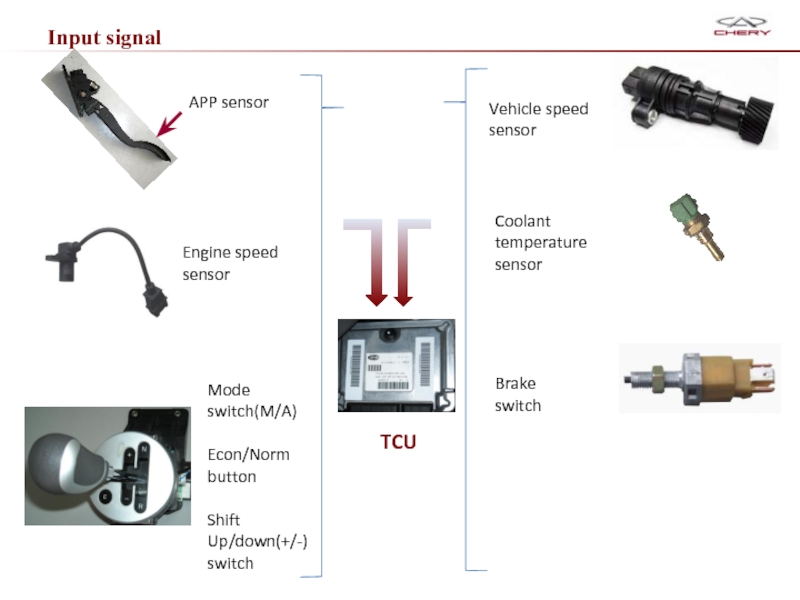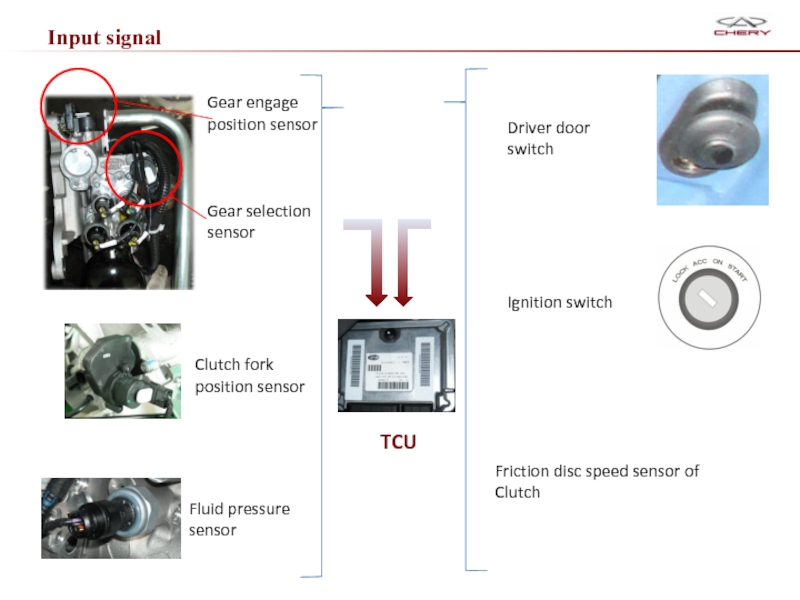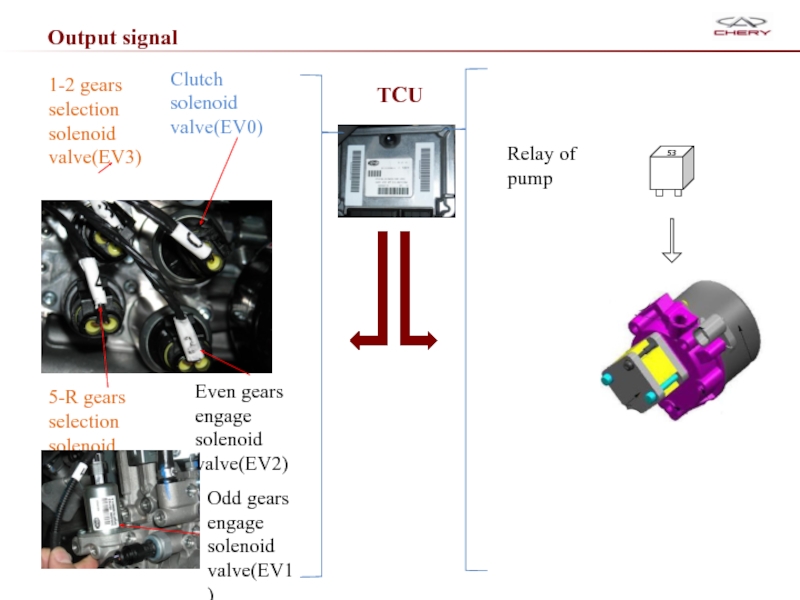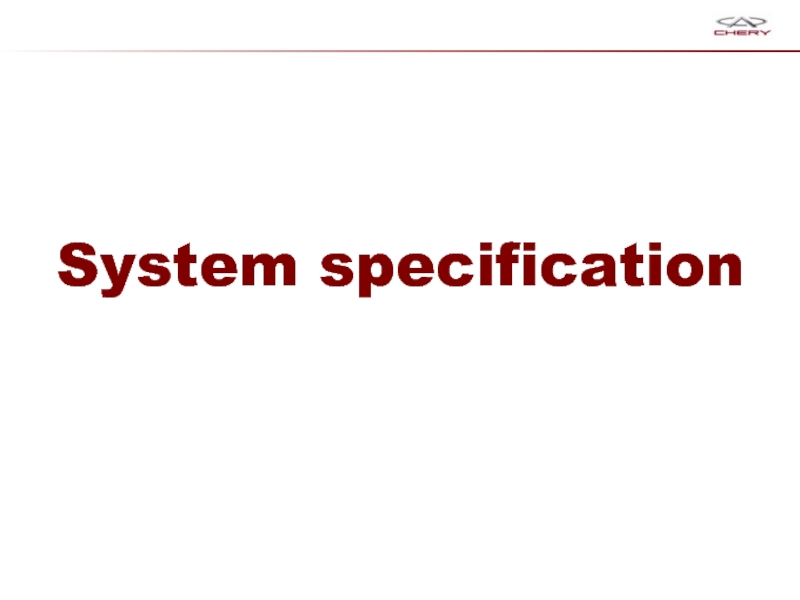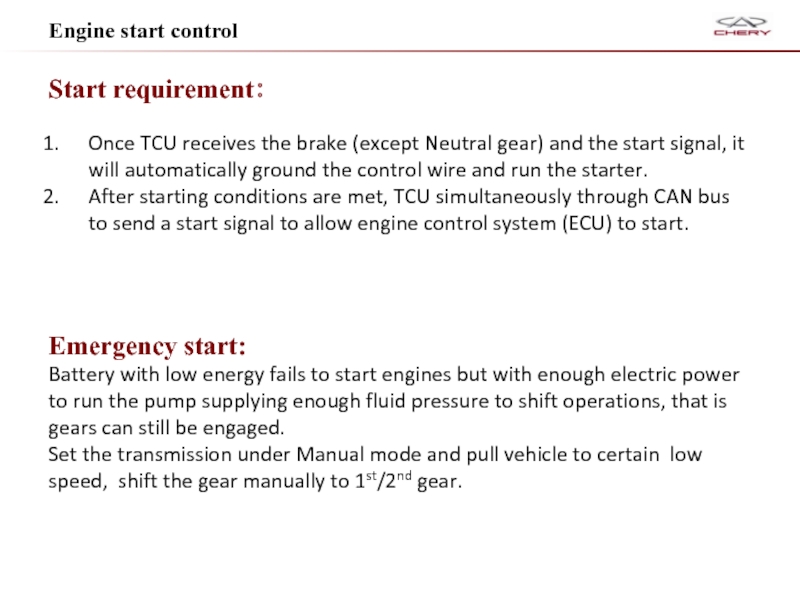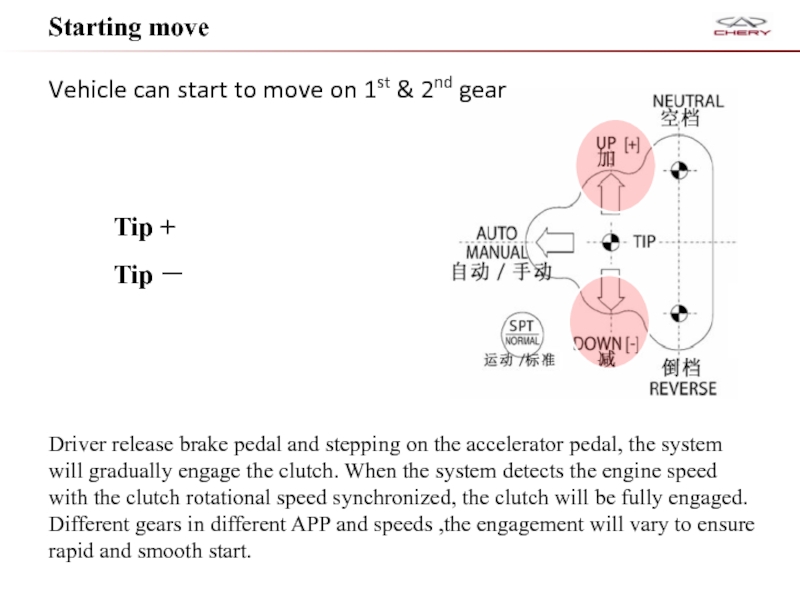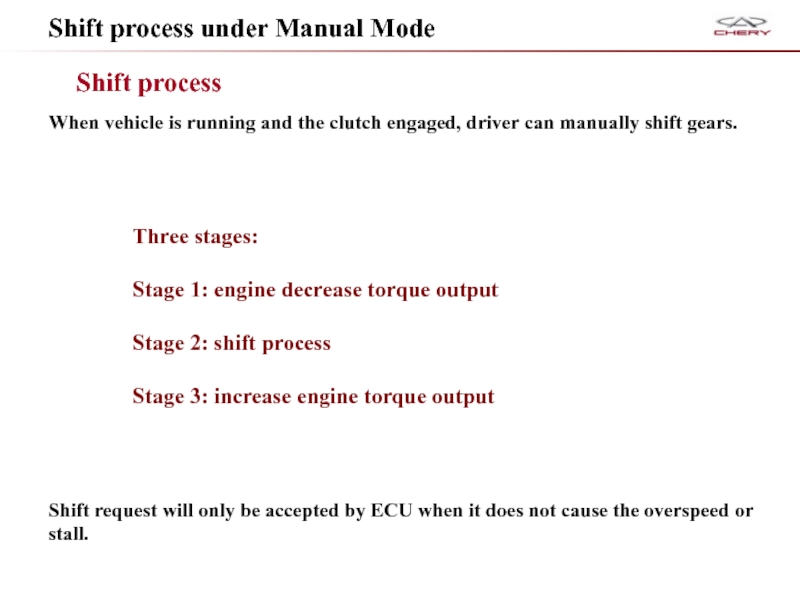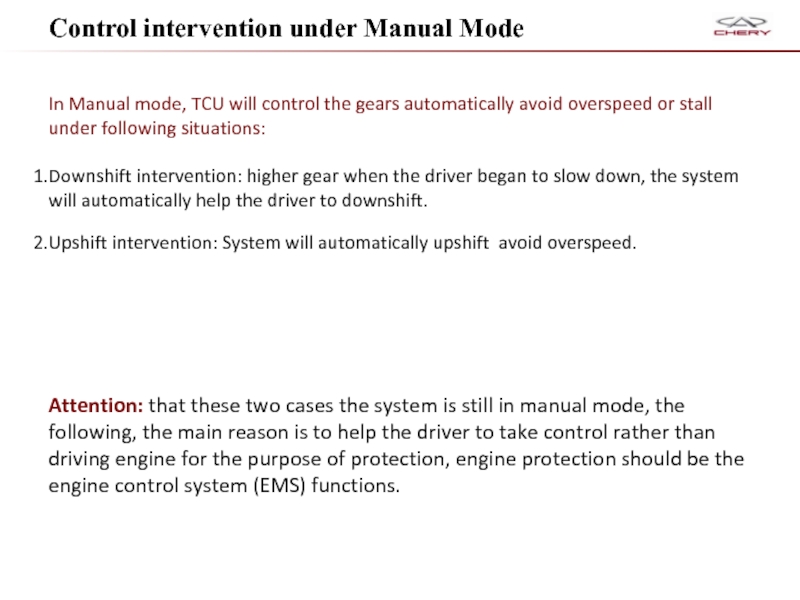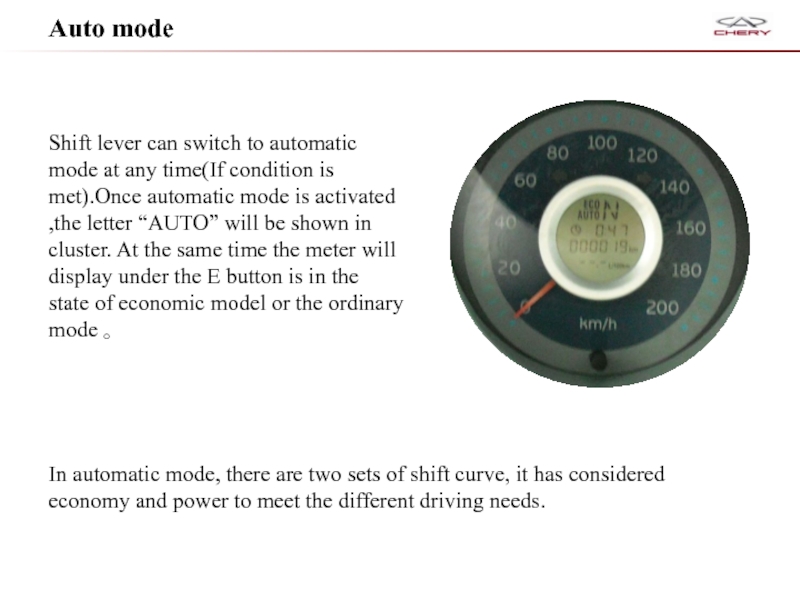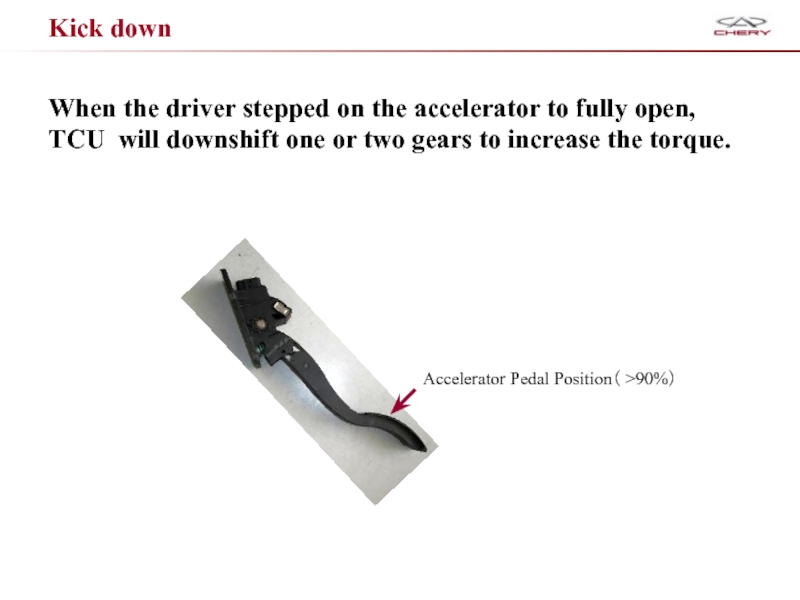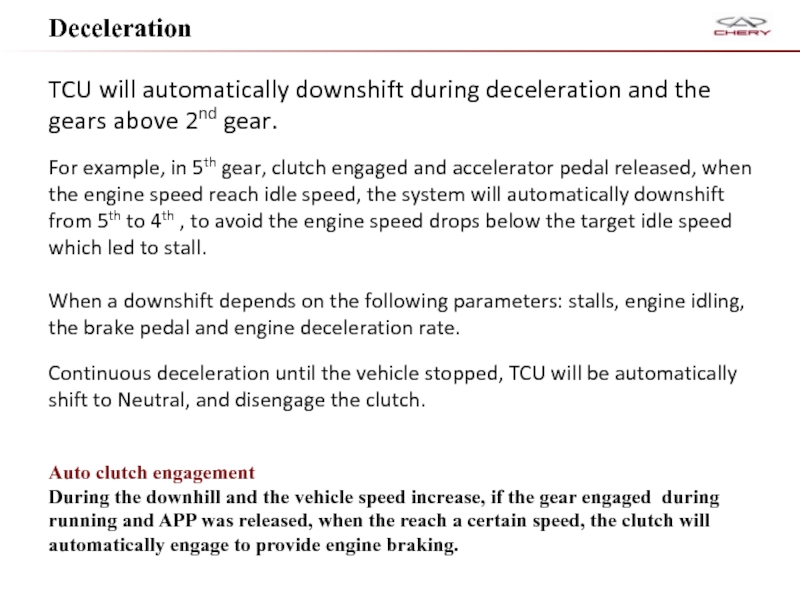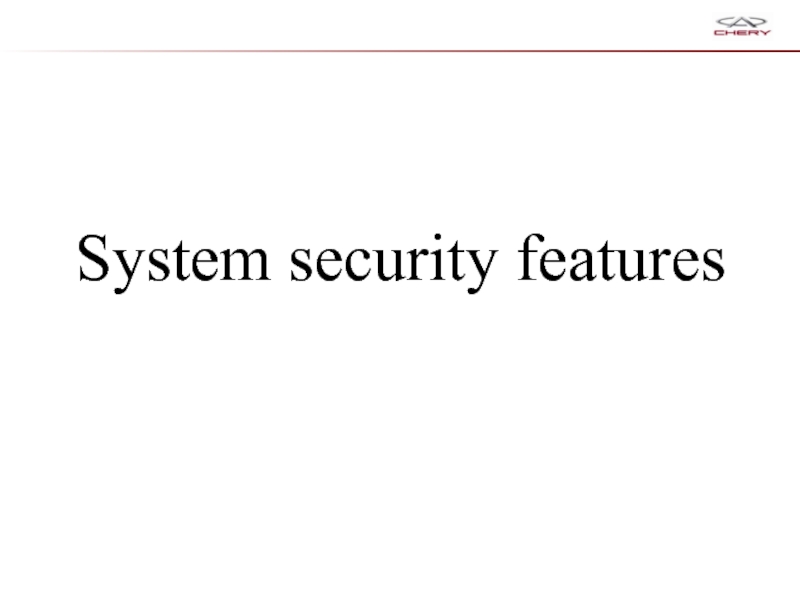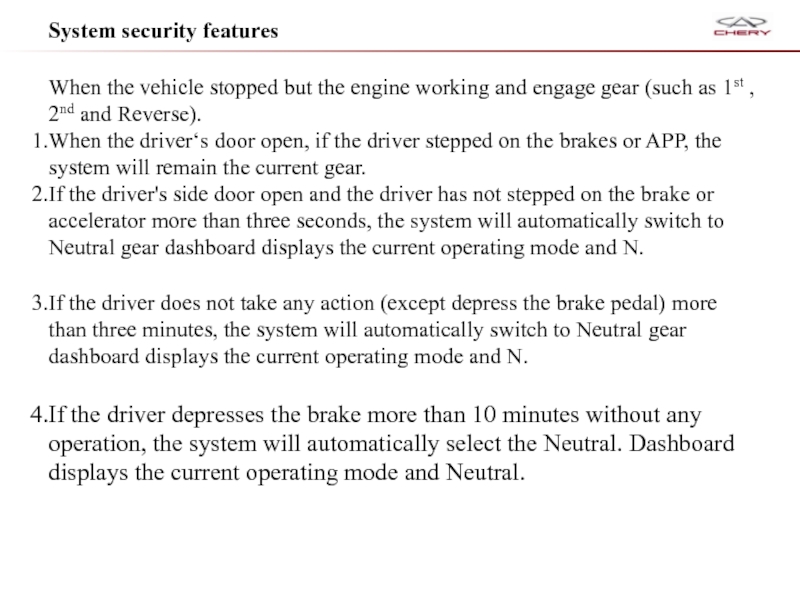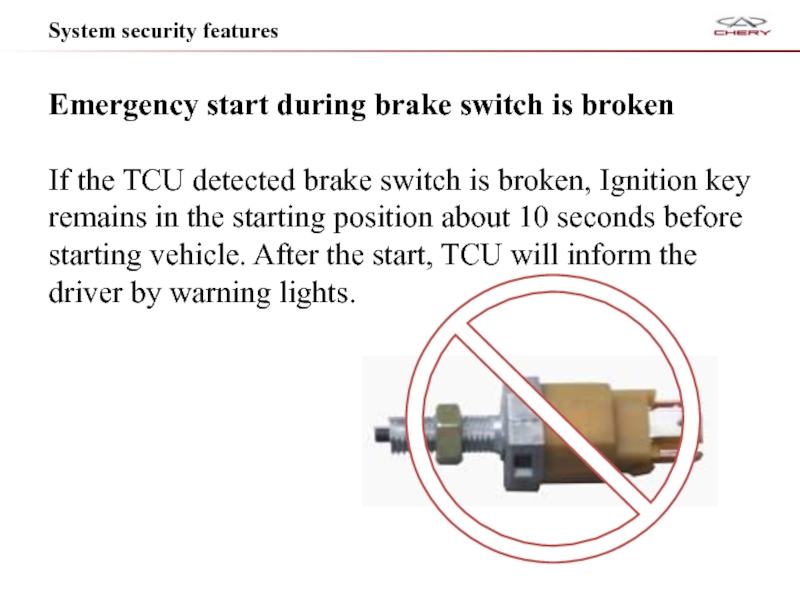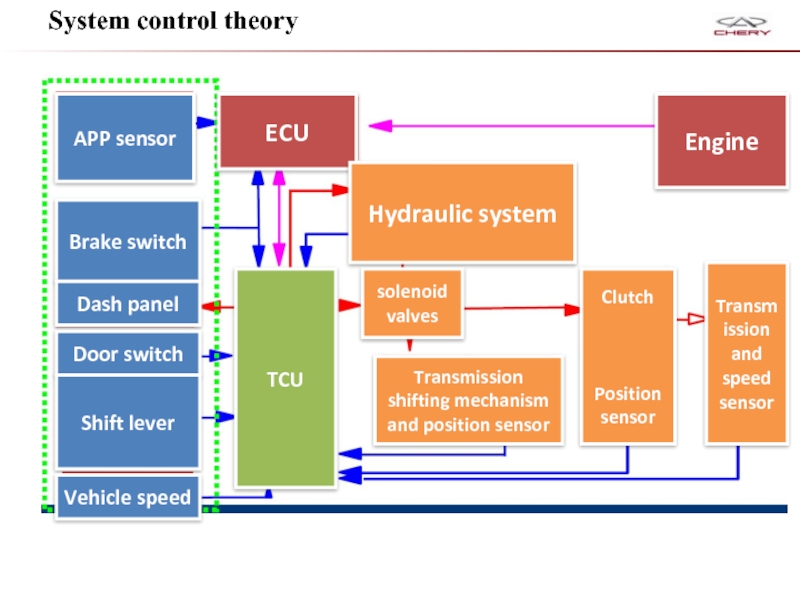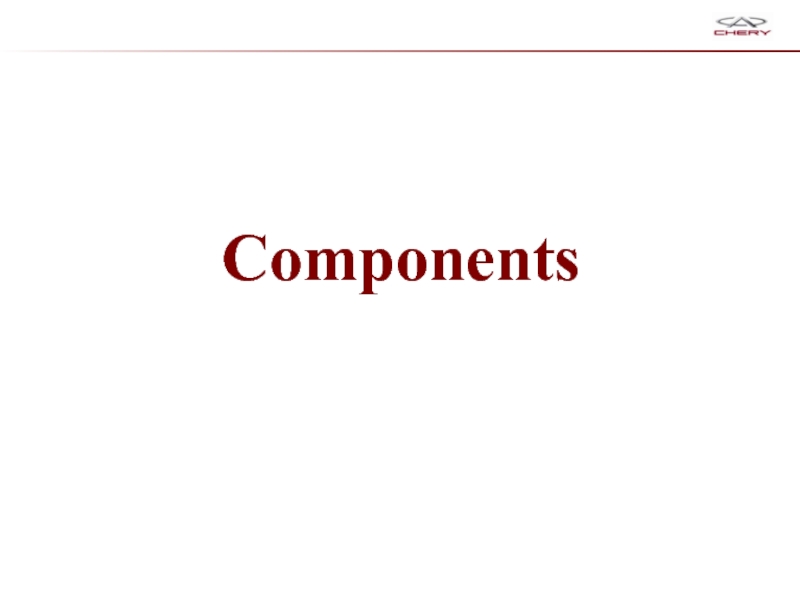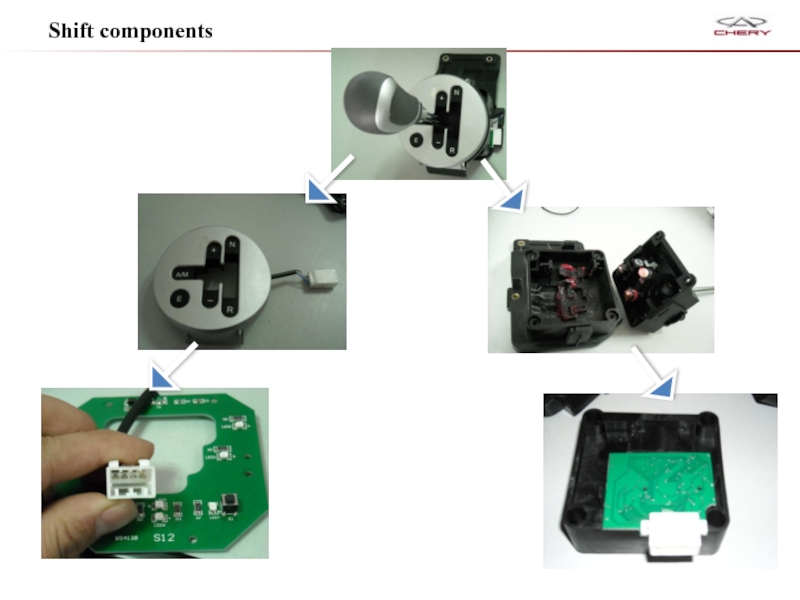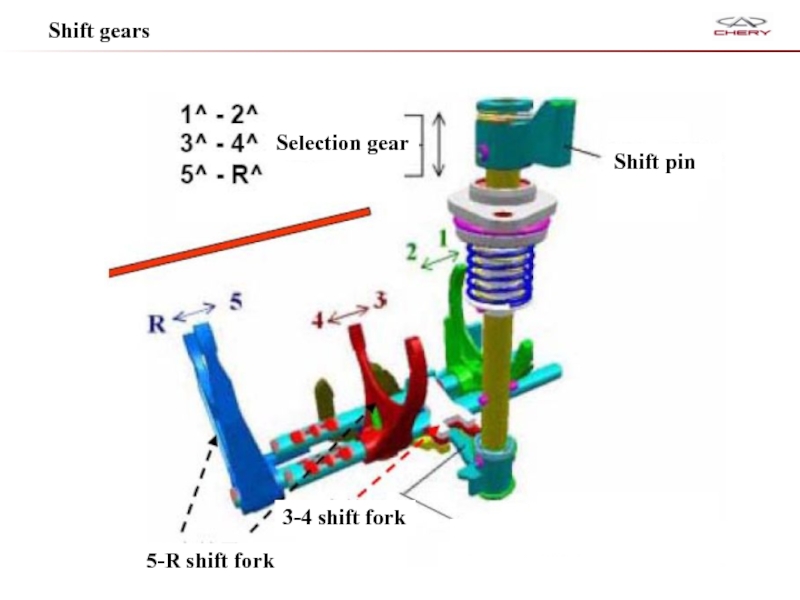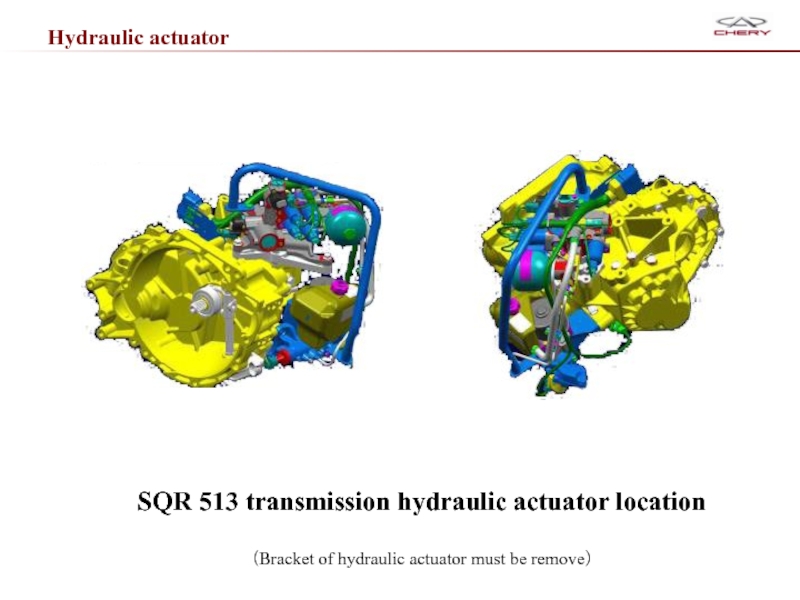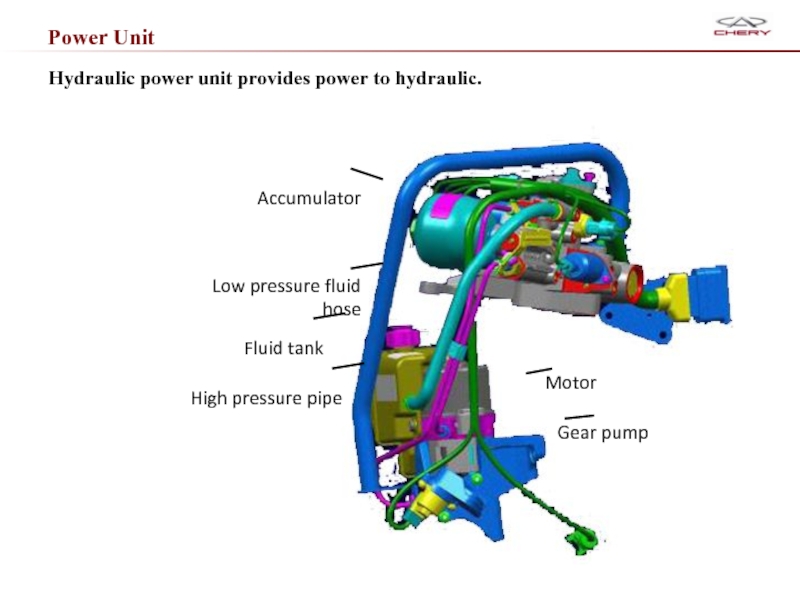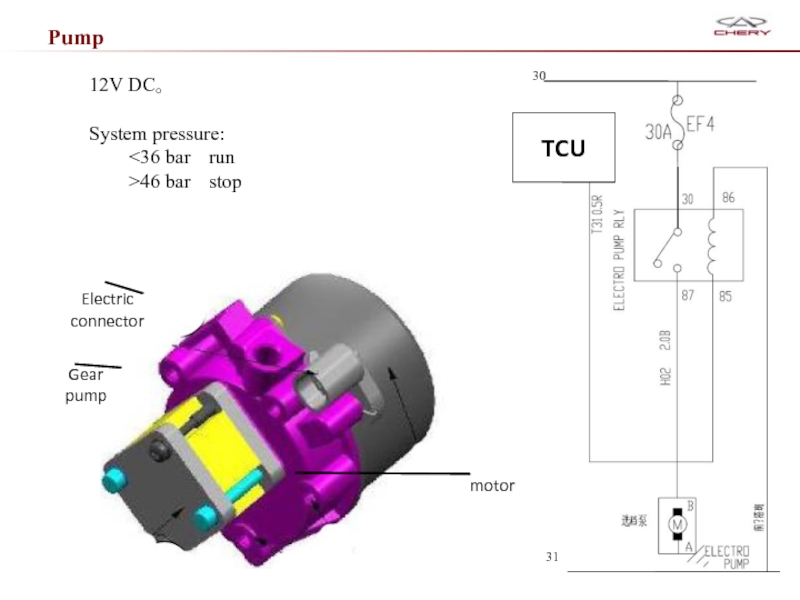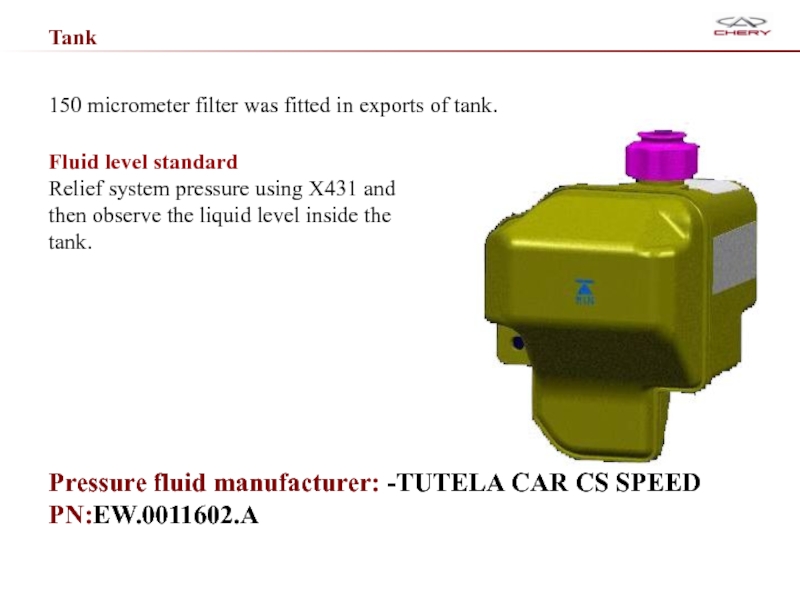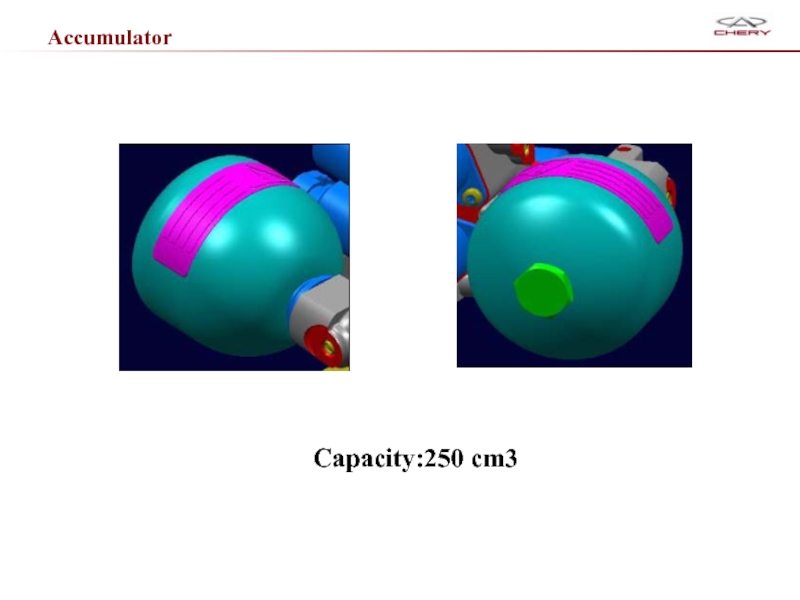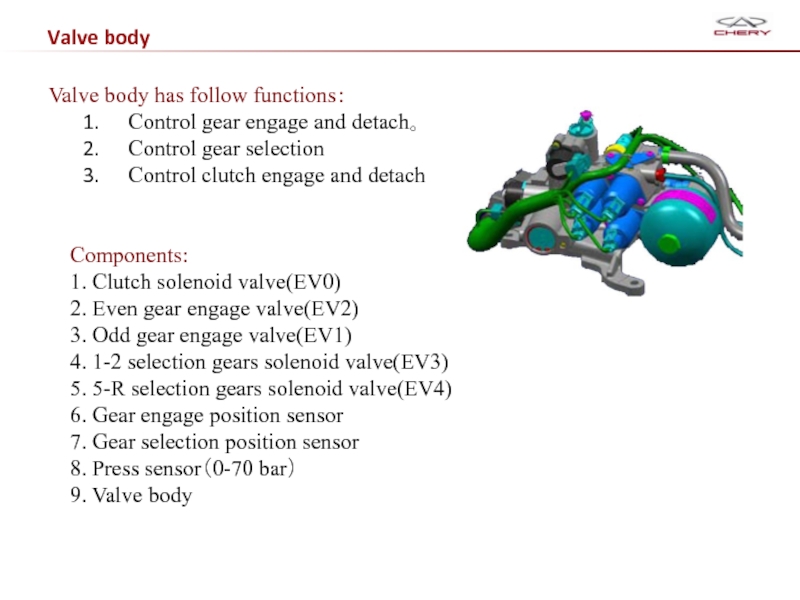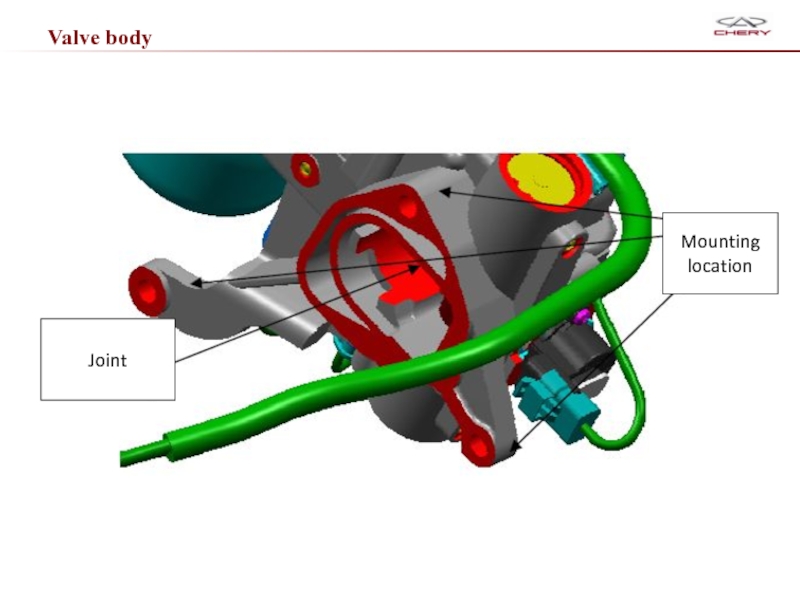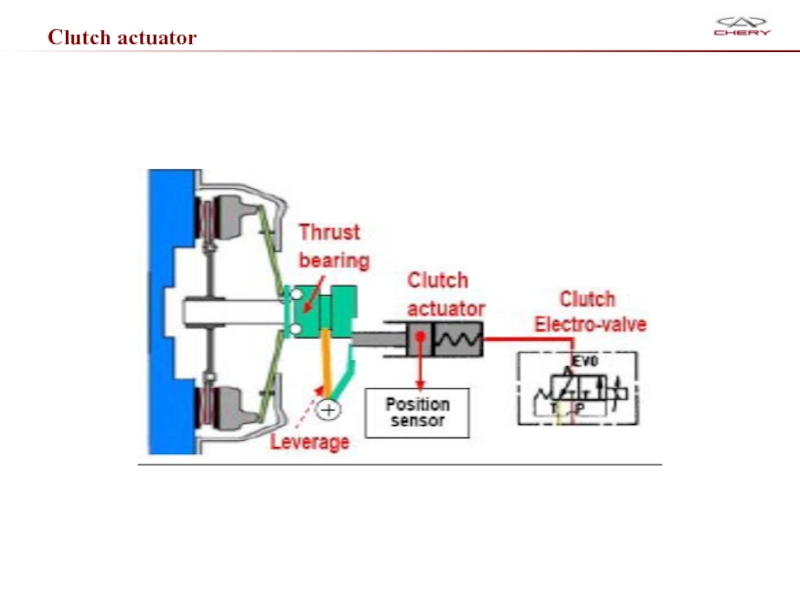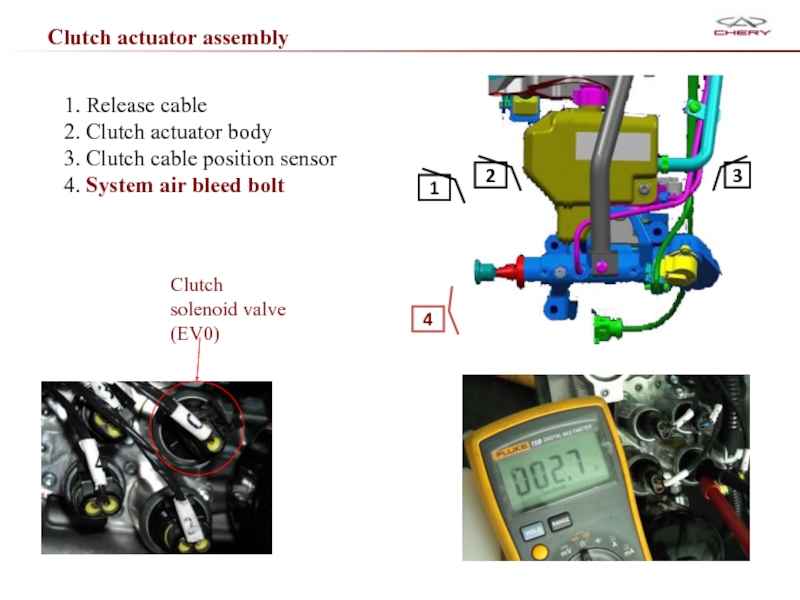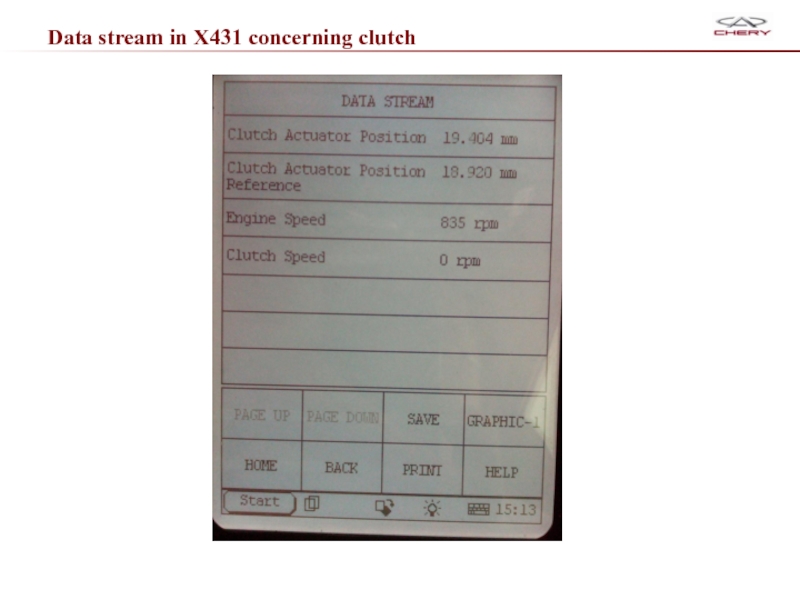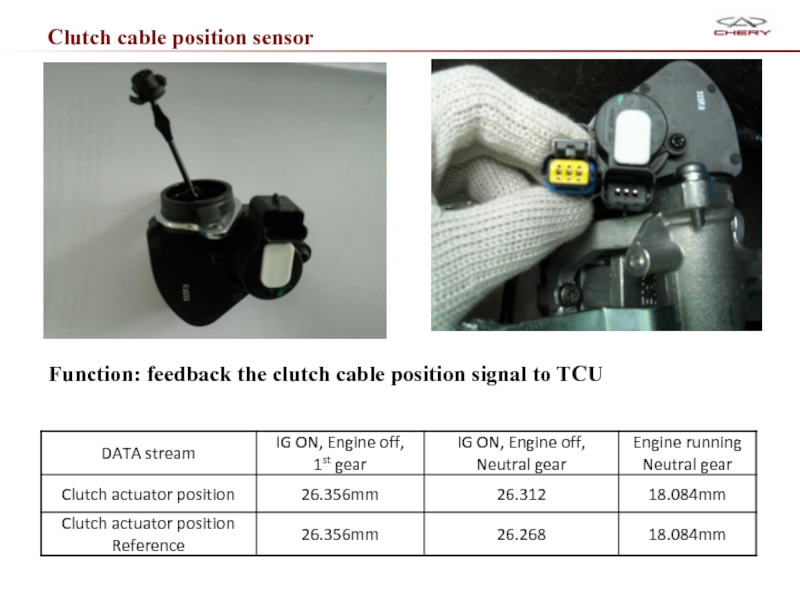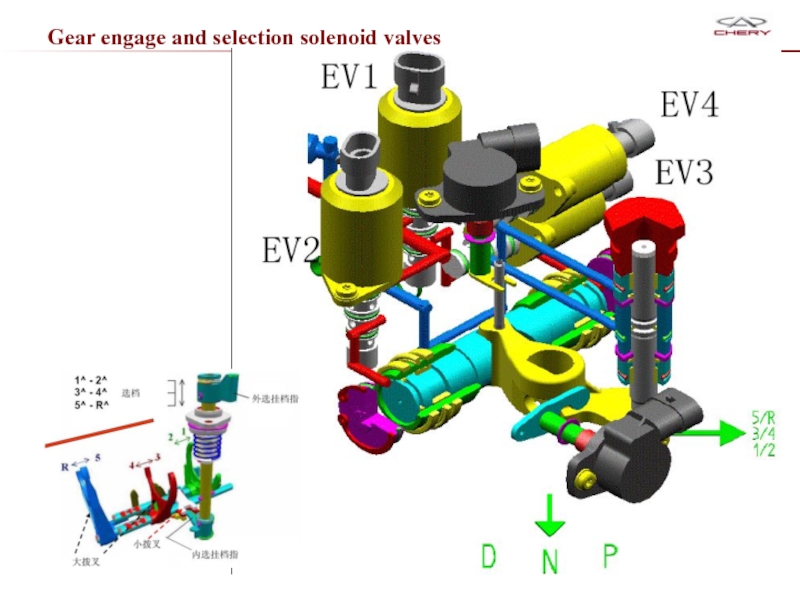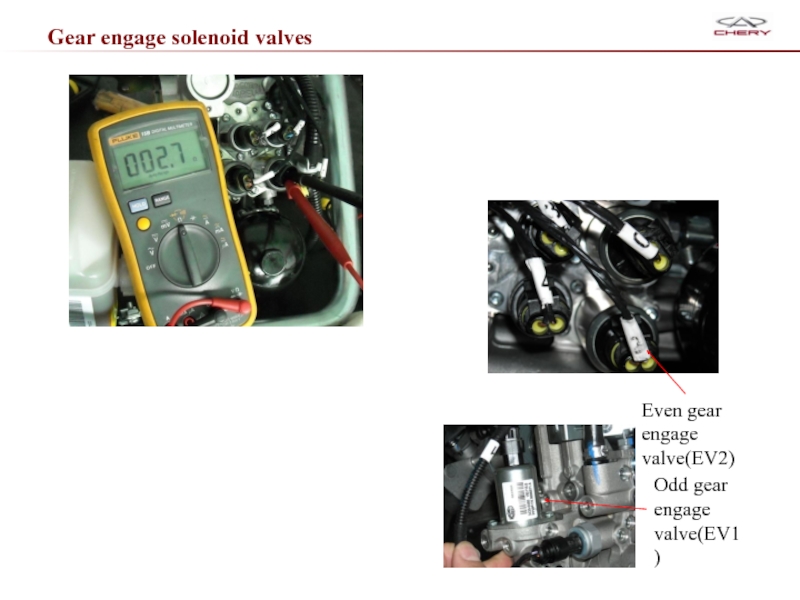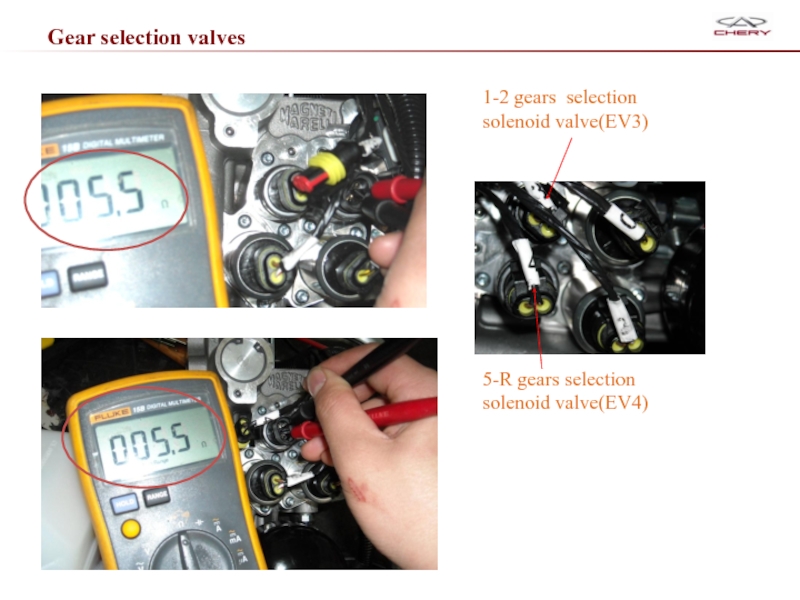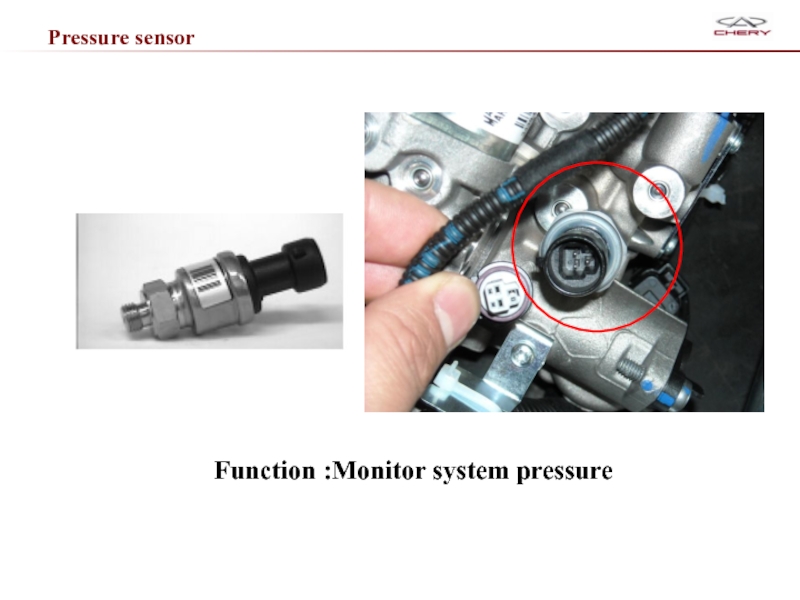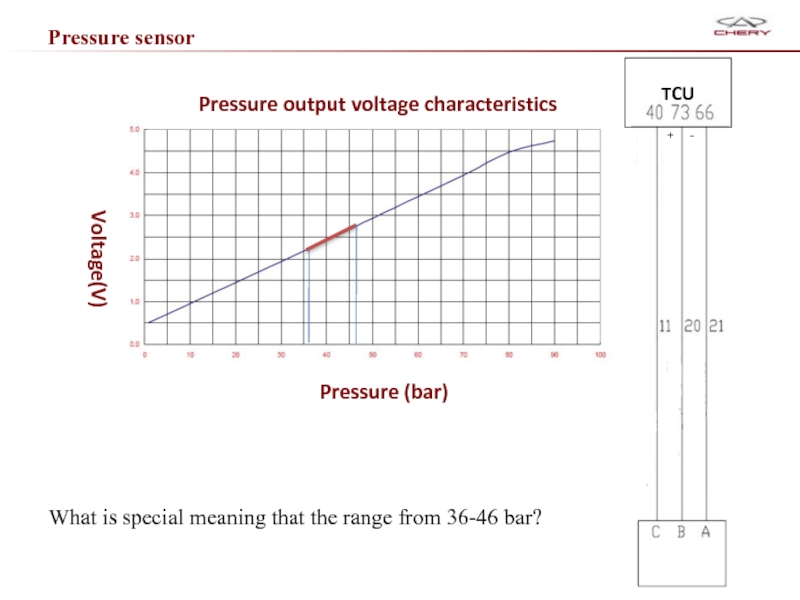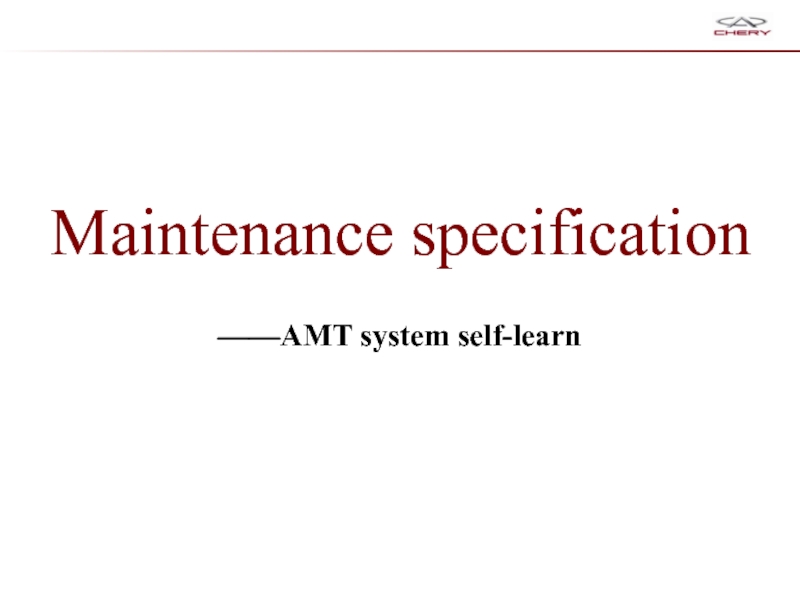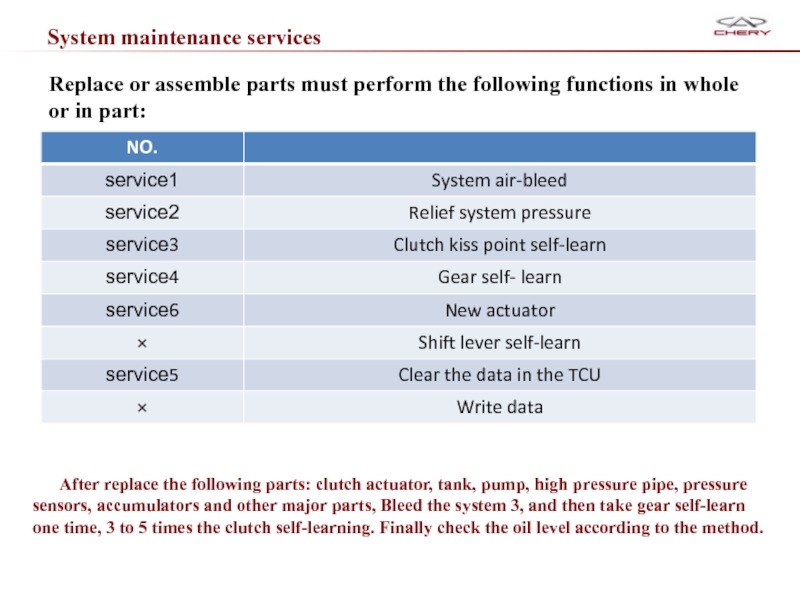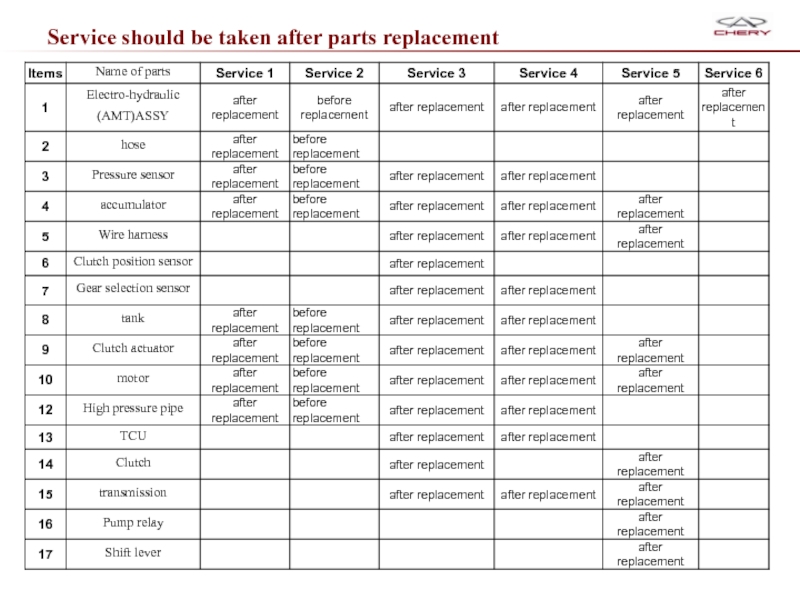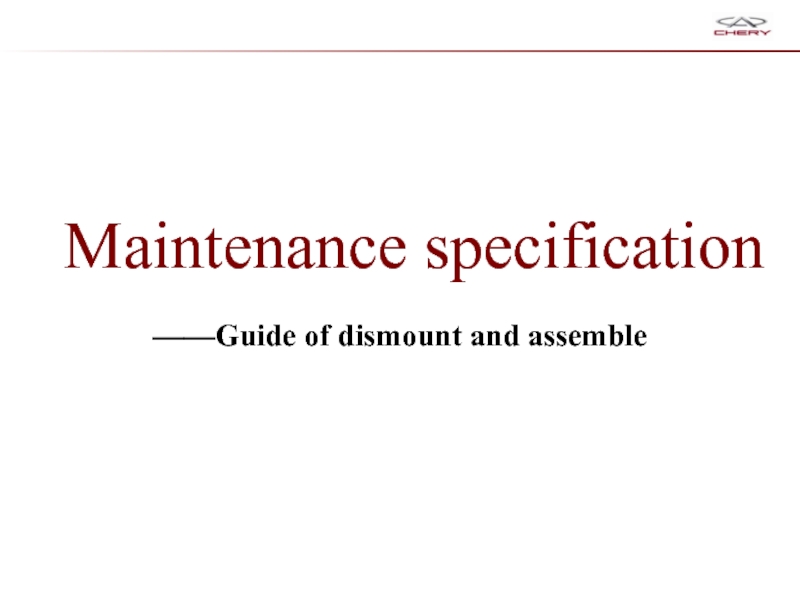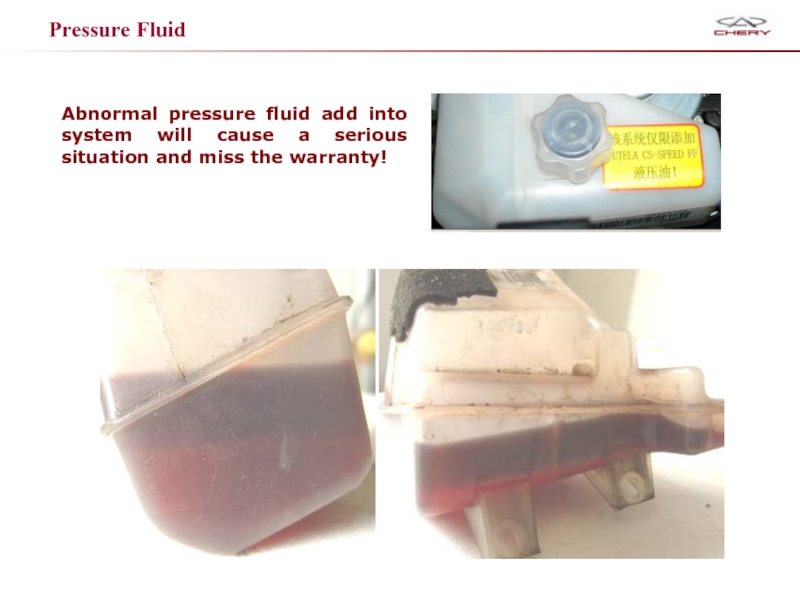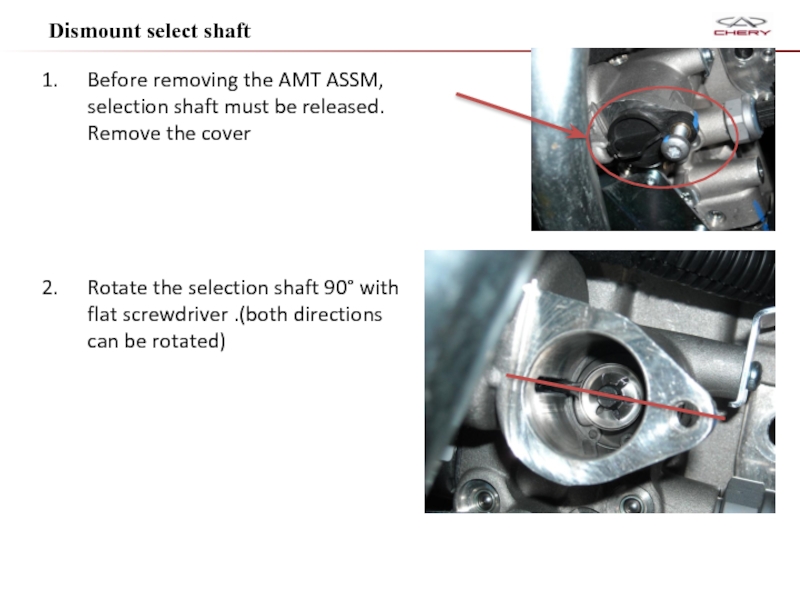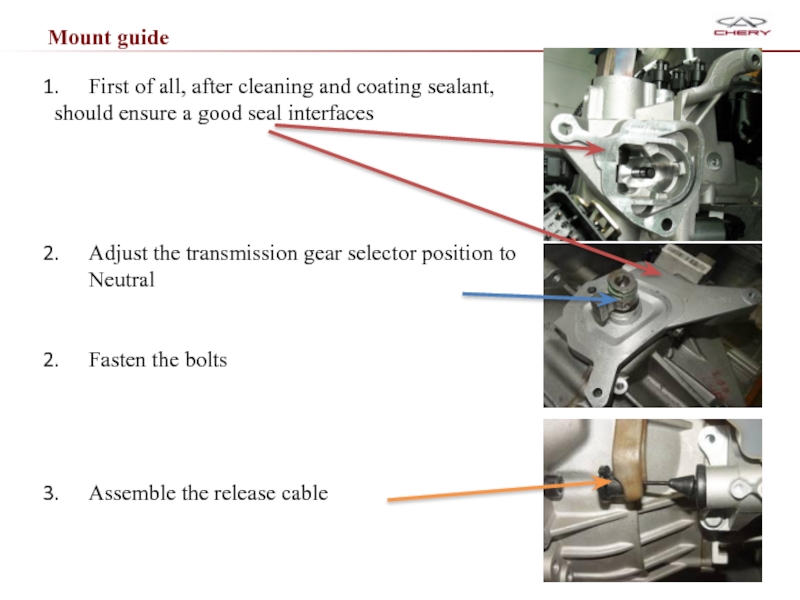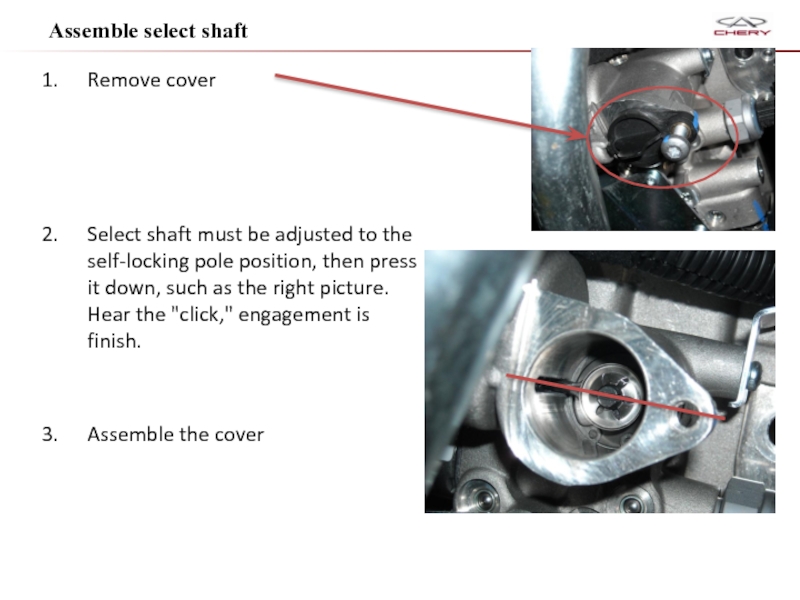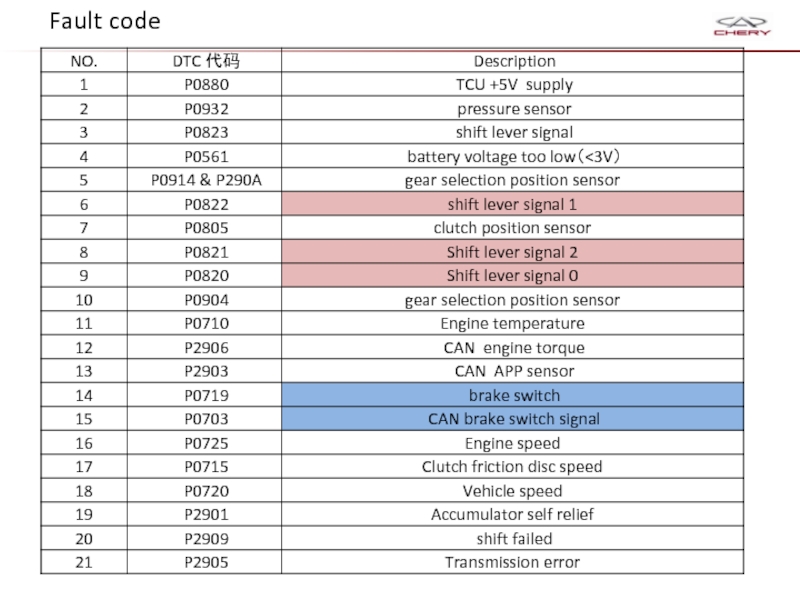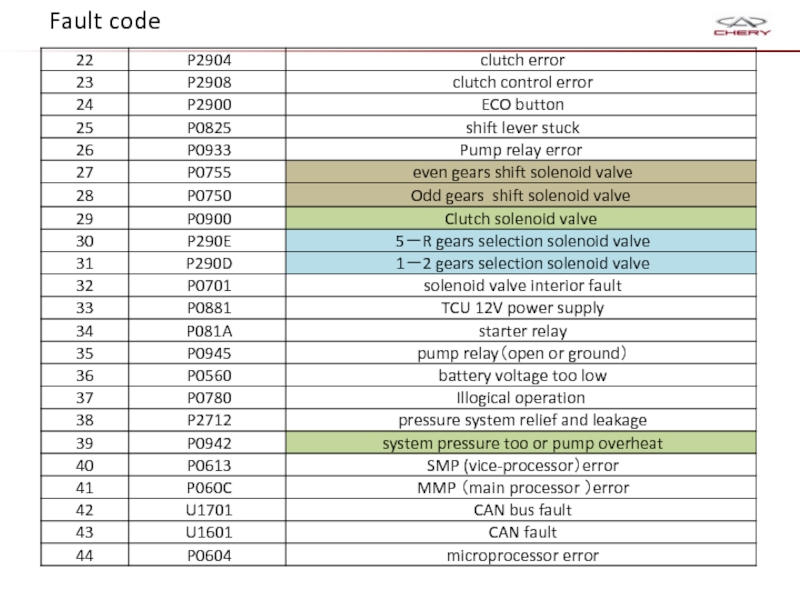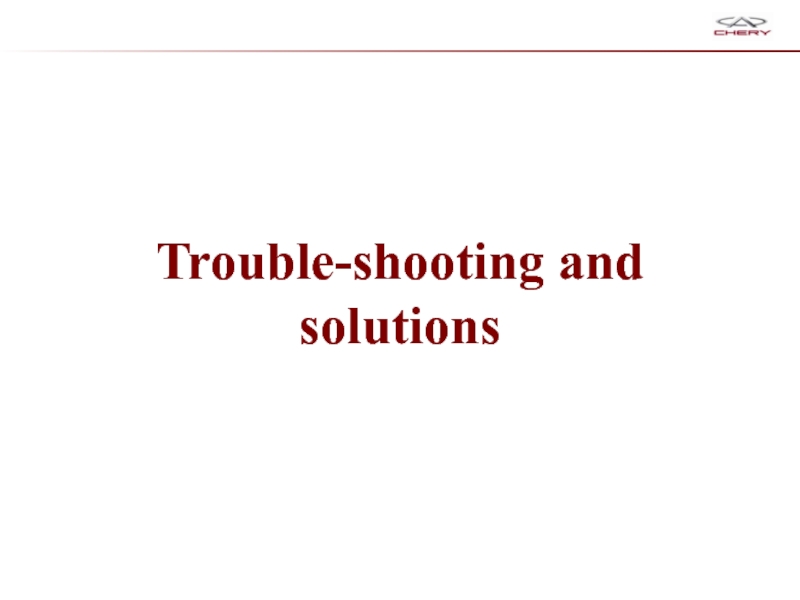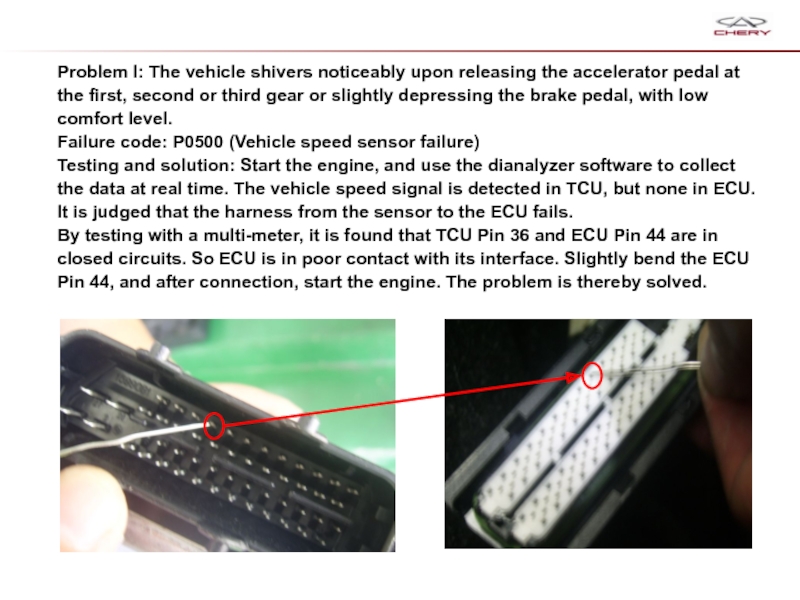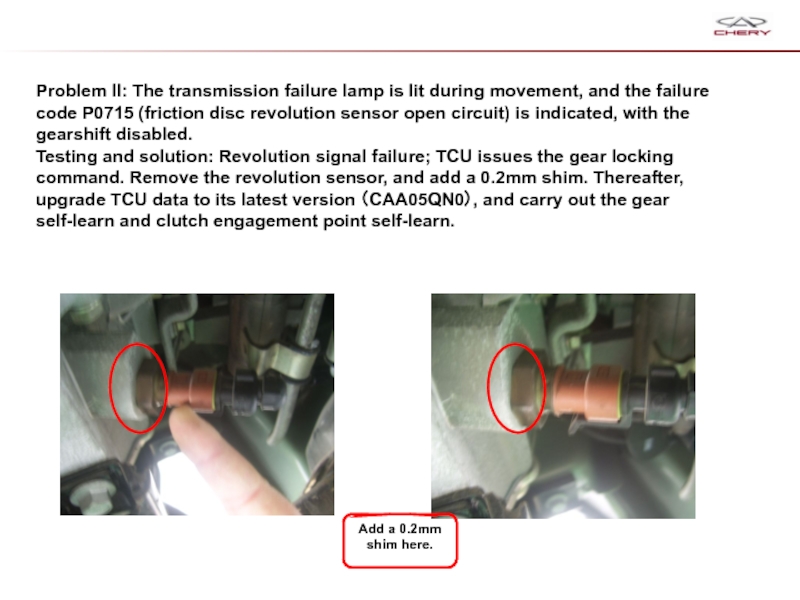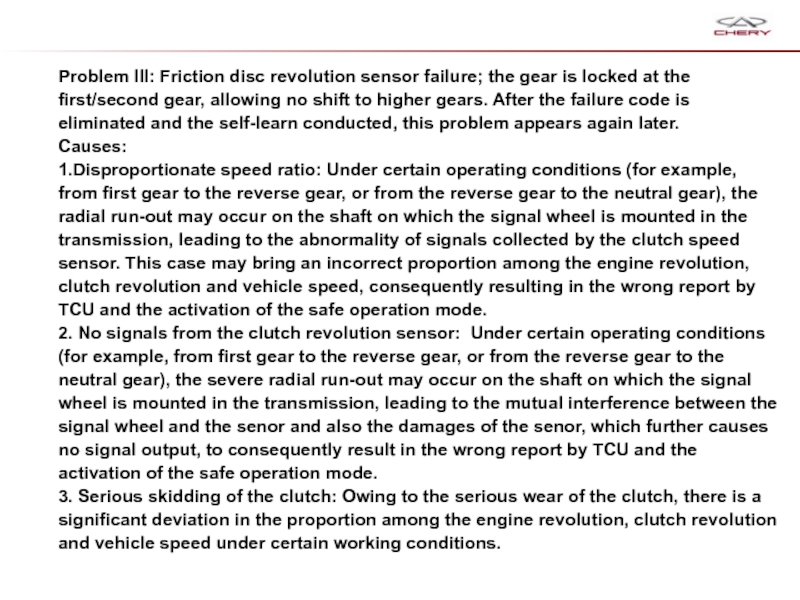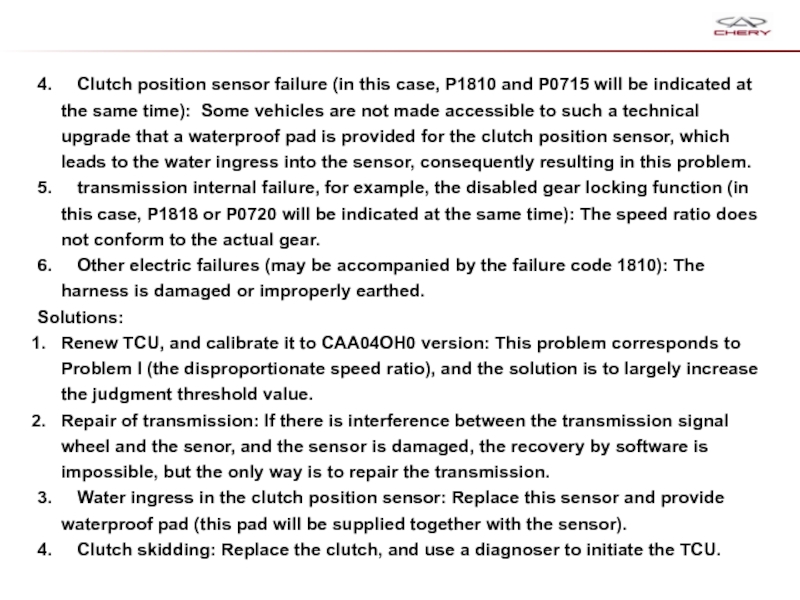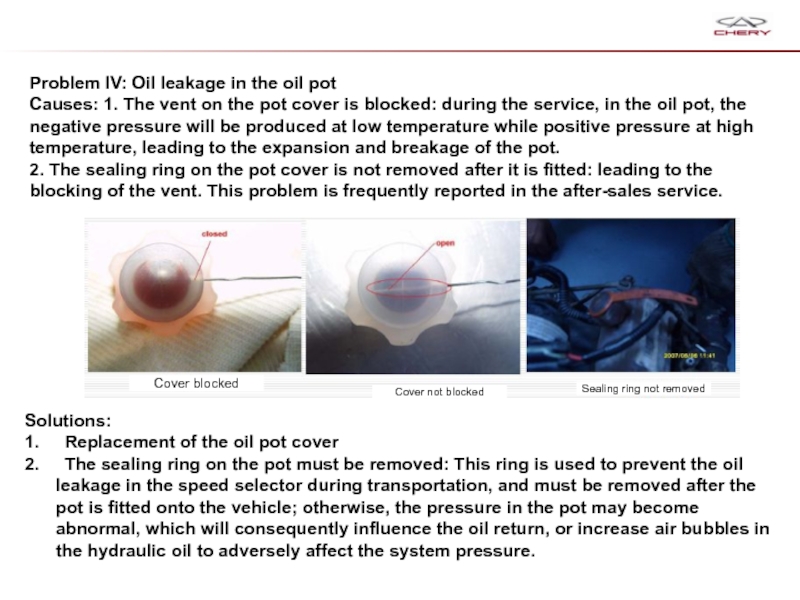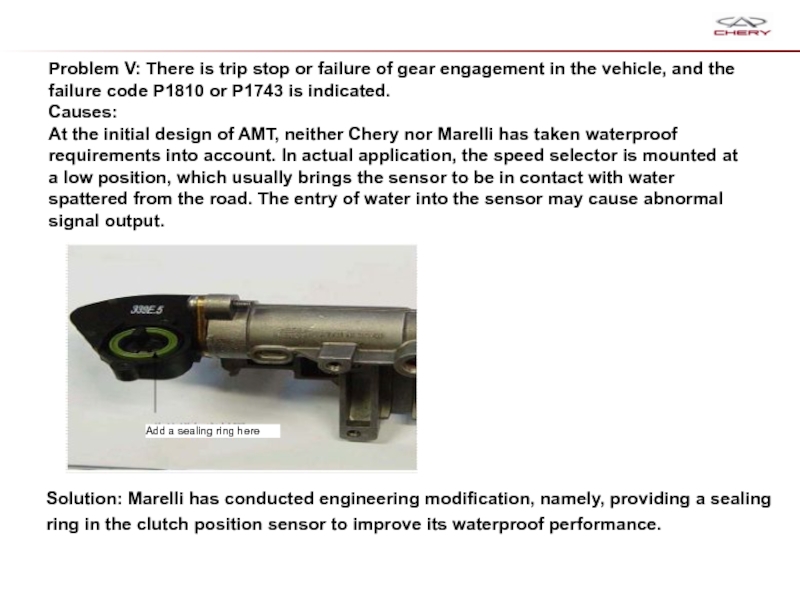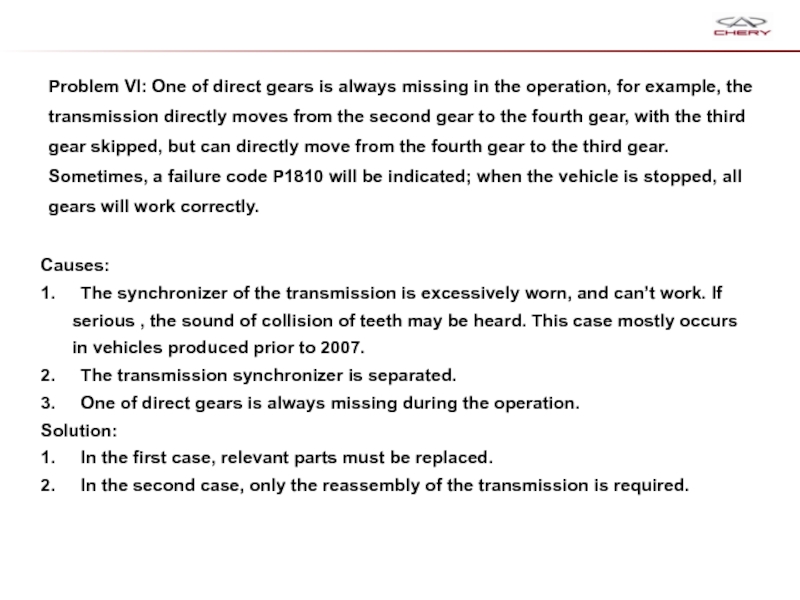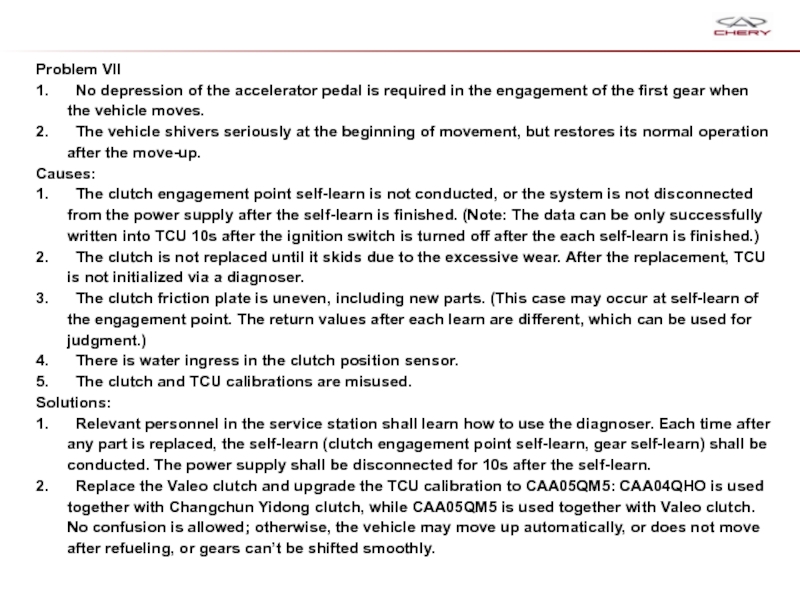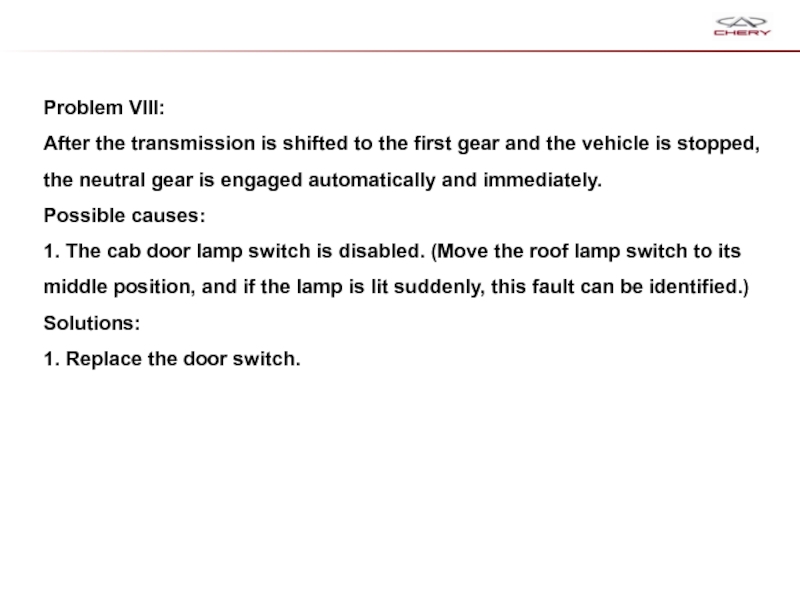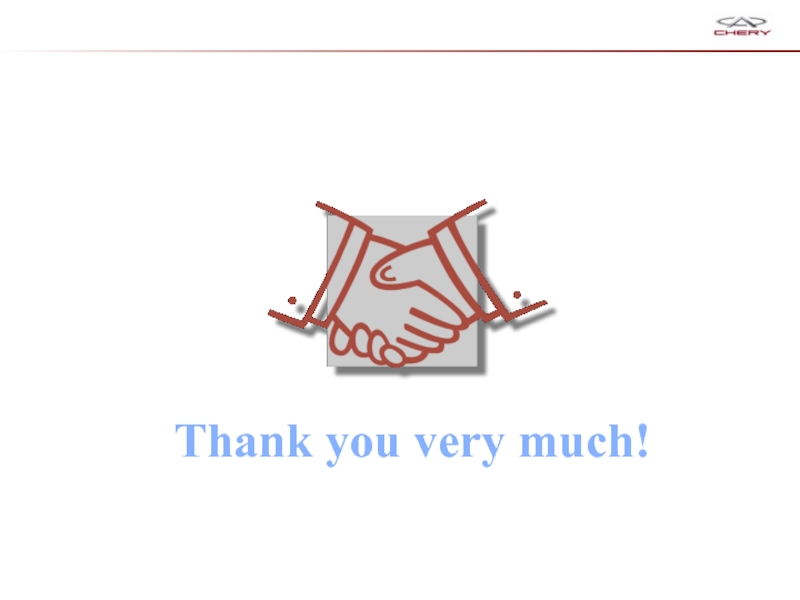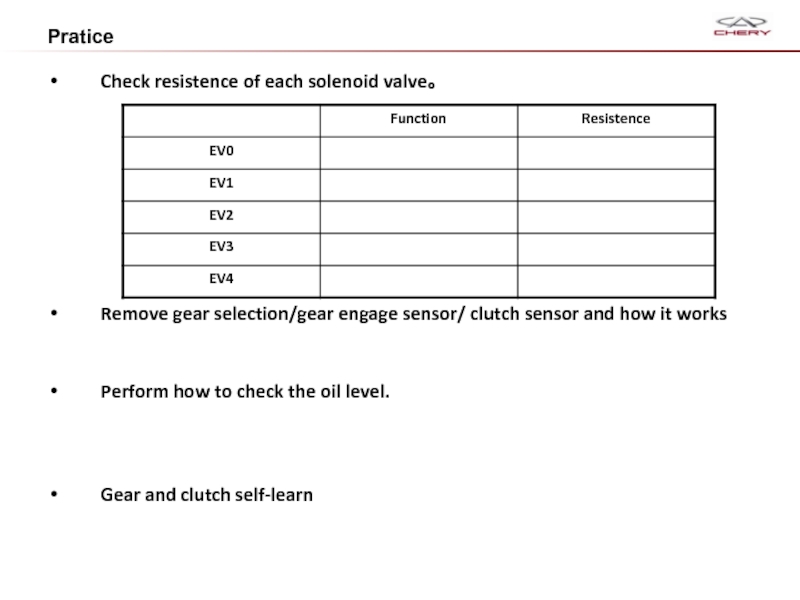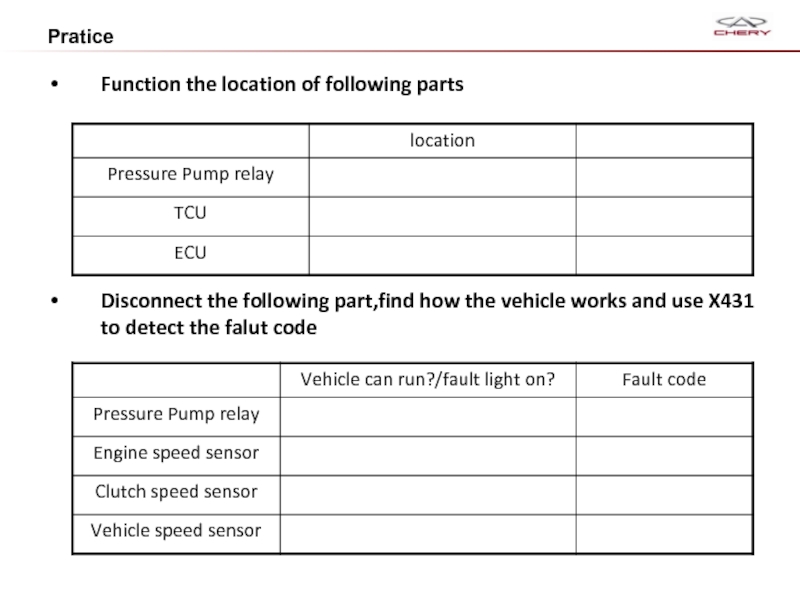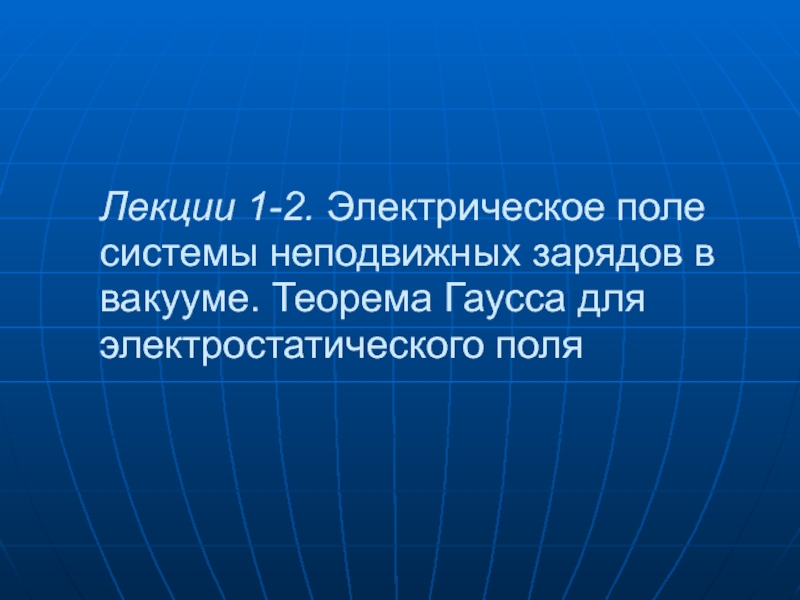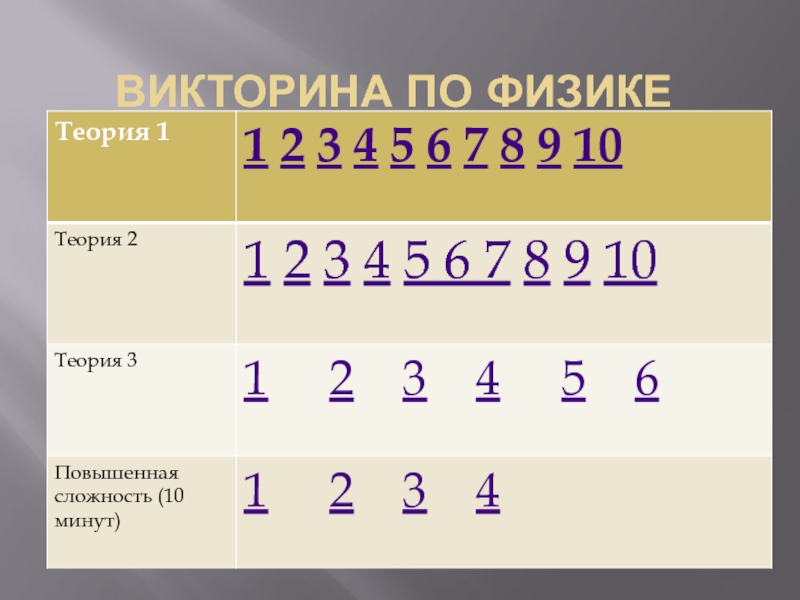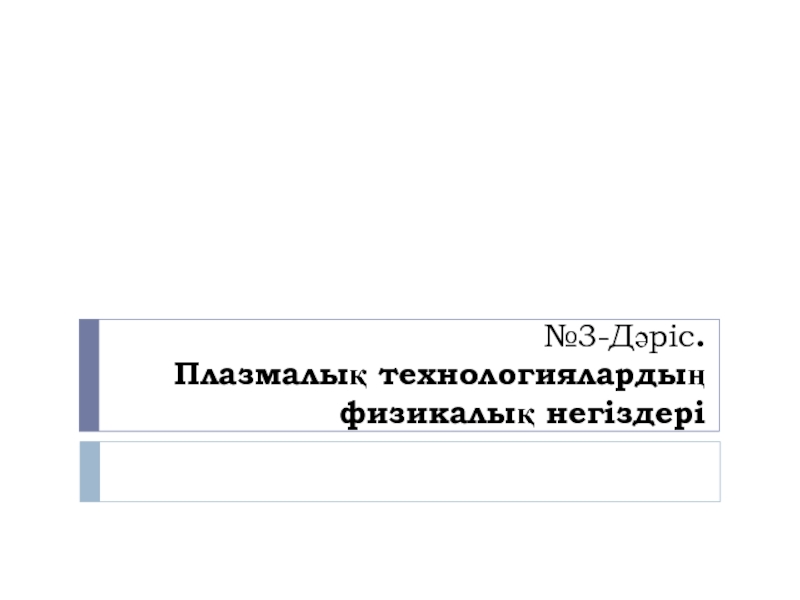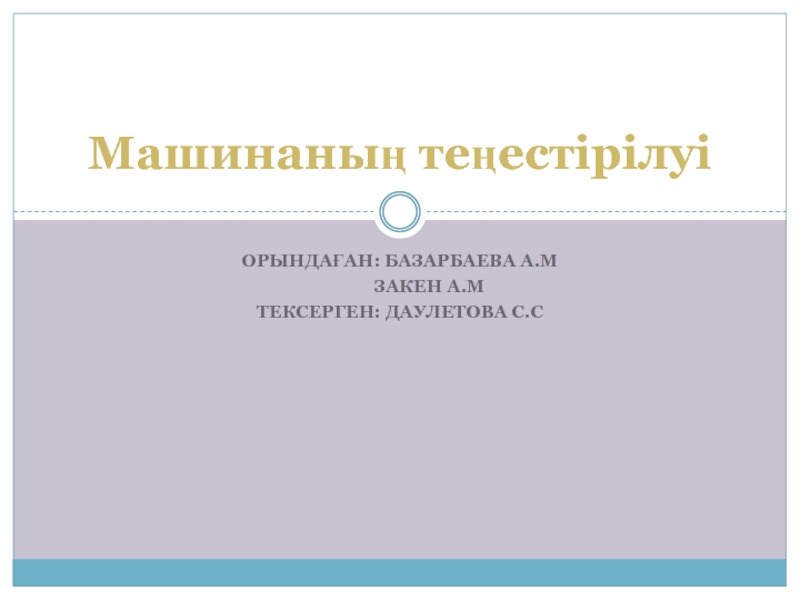- Главная
- Разное
- Дизайн
- Бизнес и предпринимательство
- Аналитика
- Образование
- Развлечения
- Красота и здоровье
- Финансы
- Государство
- Путешествия
- Спорт
- Недвижимость
- Армия
- Графика
- Культурология
- Еда и кулинария
- Лингвистика
- Английский язык
- Астрономия
- Алгебра
- Биология
- География
- Детские презентации
- Информатика
- История
- Литература
- Маркетинг
- Математика
- Медицина
- Менеджмент
- Музыка
- МХК
- Немецкий язык
- ОБЖ
- Обществознание
- Окружающий мир
- Педагогика
- Русский язык
- Технология
- Физика
- Философия
- Химия
- Шаблоны, картинки для презентаций
- Экология
- Экономика
- Юриспруденция
AMT Technical Training. Automatic Mechanical Transmission презентация
Содержание
- 1. AMT Technical Training. Automatic Mechanical Transmission
- 2. Kindly attention: 1.The course will take you
- 3. Catalog Components Service standard Trouble-shooting and solutions
- 4. System overview
- 5. Following information display on LCD and cluster:
- 6. System layout 1ECU 2 Electrohydraulic unit 3TCU 4 Cluster 5Econ/Norm button 6brake switch 7Shift lever 8Accelerator
- 7. System introduction On the basis of
- 8. Shift lever position with three stable
- 9. Shift to Neutral during running APP sensor released Vehicle speed
- 10. Shift to Reverse Brake pedal was depressed Vehicle speed
- 11. Possible following situation may cause when the
- 12. Knowledge prepration Three types of
- 13. Electrohydraulic Mechanism
- 14. ECU
- 15. Input signal TCU APP sensor
- 16. Input signal TCU
- 17. Output signal TCU
- 18. System specification
- 19. System will be woke up in two
- 20. Engine start control Start requirement: Once TCU
- 21. Vehicle can start to move on 1st
- 22. Shift process under Manual Mode Shift process
- 23. Control intervention under Manual Mode In Manual
- 24. Auto mode Shift lever can switch to
- 25. When the driver stepped on the accelerator
- 26. Deceleration TCU will automatically downshift during deceleration
- 27. System security features
- 28. When the vehicle stopped but the engine
- 29. Emergency start during brake switch is broken
- 30. System control theory APP sensor Brake switch
- 31. Components
- 32. Shift components
- 33. Shift gears Shift pin Selection
- 34. Hydraulic actuator SQR 513 transmission hydraulic actuator
- 35. Power Unit Hydraulic power unit provides power
- 36. Pump 12V DC。 System pressure: 46 bar stop TCU 30 31
- 37. Tank 150 micrometer filter was fitted in
- 38. Accumulator Capacity:250 cm3
- 39. Valve body Valve body has follow functions:
- 40. Valve body Joint Mounting location
- 41. Clutch actuator
- 42. Clutch actuator assembly 1. Release cable 2.
- 43. Data stream in X431 concerning clutch
- 44. Clutch cable position sensor Function: feedback the clutch cable position signal to TCU
- 45. Gear engage and selection solenoid valves
- 46. Gear engage solenoid valves Even gear engage valve(EV2) Odd gear engage valve(EV1)
- 47. Gear selection valves 1-2 gears selection solenoid valve(EV3) 5-R gears selection solenoid valve(EV4)
- 48. Summary of solenoid valves
- 49. Pressure sensor Function :Monitor system pressure
- 50. Pressure sensor What is special meaning that
- 51. Maintenance specification ——AMT system self-learn
- 52. System maintenance services Replace or assemble parts
- 53. Service should be taken after parts replacement
- 54. ——Guide of dismount and assemble Maintenance specification
- 55. Pressure Fluid Abnormal pressure fluid add into
- 56. Before removing the AMT ASSM, selection shaft
- 57. Mount guide First of all, after cleaning
- 58. Remove cover Select
- 59. Fault code
- 60. Fault code
- 61. Trouble-shooting and solutions
- 62. Problem I: The vehicle shivers noticeably upon
- 63. Problem II: The transmission failure lamp is
- 64. Problem III: Friction disc revolution sensor failure;
- 65. 4. Clutch position sensor failure (in this
- 66. Problem IV: Oil leakage in the oil
- 67. Problem V: There is trip stop or
- 68. Problem VI: One of direct gears is
- 69. Problem VII 1. No depression of
- 70. Problem VIII: After the transmission is
- 71. Thank you very much!
- 72. Pratice Check resistence of each solenoid valve。
- 73. Pratice Function the location of following parts
Слайд 1
AMT Technical Training
Automatic Mechanical Transmission
Sandy · Mar, 2010
After-sale Service Department
Слайд 2Kindly attention:
1.The course will take you approx 45 minutes
2.Please linsten carefully,and
3.Please refer to the remarks at the bottom
4.Keep your cellphone on mute condition
Слайд 5Following information display on LCD and cluster:
Current gears, Current mode(Auto/Manual)
Normal/Economical(Shifting pattern
Fault light
Buzzer in cluster will work under following conditions:
Reverse gear request to ECU
After system self-learning
Illogical gears request from shifting lever
System fault
System overview
Human-computer interface
Слайд 6System layout
1ECU 2 Electrohydraulic unit 3TCU 4 Cluster
5Econ/Norm button 6brake switch 7Shift lever 8Accelerator
Слайд 7System introduction
On the basis of the original manual transmission gearbox and
Eliminated clutch pedal and shift wires, gear lever machines were replaced by an electronic joystick marked with (+/-/ N / R) reduce costs, improve the system reliability.
Improved user interface, less operation to improve the driving safety , especially in urban conditions.
Shifting point will alter with the vehicle and driver’s willing.
Слайд 8
Shift lever position with three stable and three unstable position, the
Shift lever
Manual (semi-auto mode)
Automatic(Eco):
Automatic(Norm) :
System introduction
Слайд 11Possible following situation may cause when the driver try to move
Shift lever instructions
System will automatically switch to Neutral gear once the driver’s door opens
System introduction
Слайд 12Knowledge prepration
Three types of operation on transmission are replace by Actuator
Clutch release fork
Engage direction
Select direction
Слайд 14
ECU
Clutch fork position--?
Gear selected position?
Gear engaged position?
Fluid pressure----------?
Shift lever input--------?
Driver’s door switch--?
Ignition switch ---------?
----- ??Gear selection solenoid valve 1
----- ??Gear selection solenoid valve 2
----- ??Gear engage solenoid valve 1
----- ??Gear engage solenoid valve 2
----- ??Clutch solenoid valve
<--- ??Instrument
AMT Electrical Control Components
Слайд 15Input signal
TCU
APP sensor
Brake switch
Mode switch(M/A)
Econ/Norm button
Shift Up/down(+/-) switch
Vehicle speed sensor
Engine
Coolant temperature sensor
Слайд 16Input signal
TCU
Gear engage position sensor
Gear selection sensor
Clutch fork position sensor
Friction disc
Driver door switch
Ignition switch
Fluid pressure sensor
Слайд 17Output signal
TCU
Clutch solenoid valve(EV0)
Even gears engage solenoid valve(EV2)
1-2 gears selection solenoid
5-R gears selection solenoid valve(EV4)
Odd gears engage solenoid valve(EV1)
Relay of pump
Слайд 19System will be woke up in two ways:
— Open the driver's
— Turn on the ignition switch.
System wake up
Слайд 20Engine start control
Start requirement:
Once TCU receives the brake (except Neutral gear)
After starting conditions are met, TCU simultaneously through CAN bus to send a start signal to allow engine control system (ECU) to start.
Emergency start:
Battery with low energy fails to start engines but with enough electric power to run the pump supplying enough fluid pressure to shift operations, that is gears can still be engaged.
Set the transmission under Manual mode and pull vehicle to certain low speed, shift the gear manually to 1st/2nd gear.
Слайд 21Vehicle can start to move on 1st & 2nd gear
Starting move
Driver
Tip +
Tip -
Слайд 22Shift process under Manual Mode
Shift process
When vehicle is running and the
Three stages:
Stage 1: engine decrease torque output
Stage 2: shift process
Stage 3: increase engine torque output
Shift request will only be accepted by ECU when it does not cause the overspeed or stall.
Слайд 23Control intervention under Manual Mode
In Manual mode, TCU will control the
Downshift intervention: higher gear when the driver began to slow down, the system will automatically help the driver to downshift.
Upshift intervention: System will automatically upshift avoid overspeed.
Attention: that these two cases the system is still in manual mode, the following, the main reason is to help the driver to take control rather than driving engine for the purpose of protection, engine protection should be the engine control system (EMS) functions.
Слайд 24Auto mode
Shift lever can switch to automatic mode at any time(If
In automatic mode, there are two sets of shift curve, it has considered economy and power to meet the different driving needs.
Слайд 25When the driver stepped on the accelerator to fully open, TCU
Accelerator Pedal Position( >90%)
Kick down
Слайд 26Deceleration
TCU will automatically downshift during deceleration and the gears above 2nd
For example, in 5th gear, clutch engaged and accelerator pedal released, when the engine speed reach idle speed, the system will automatically downshift from 5th to 4th , to avoid the engine speed drops below the target idle speed which led to stall.
When a downshift depends on the following parameters: stalls, engine idling, the brake pedal and engine deceleration rate.
Continuous deceleration until the vehicle stopped, TCU will be automatically shift to Neutral, and disengage the clutch.
Auto clutch engagement
During the downhill and the vehicle speed increase, if the gear engaged during running and APP was released, when the reach a certain speed, the clutch will automatically engage to provide engine braking.
Слайд 28When the vehicle stopped but the engine working and engage gear
When the driver‘s door open, if the driver stepped on the brakes or APP, the system will remain the current gear.
If the driver's side door open and the driver has not stepped on the brake or accelerator more than three seconds, the system will automatically switch to Neutral gear dashboard displays the current operating mode and N.
If the driver does not take any action (except depress the brake pedal) more than three minutes, the system will automatically switch to Neutral gear dashboard displays the current operating mode and N.
If the driver depresses the brake more than 10 minutes without any operation, the system will automatically select the Neutral. Dashboard displays the current operating mode and Neutral.
System security features
Слайд 29Emergency start during brake switch is broken
If the TCU detected brake
System security features
Слайд 30System control theory
APP sensor
Brake switch
Dash panel
Door switch
Shift lever
Vehicle speed
TCU
ECU
Engine
Hydraulic system
solenoid valves
Transmission
Clutch
Position sensor
Transmission and speed sensor
Слайд 34Hydraulic actuator
SQR 513 transmission hydraulic actuator location
(Bracket of hydraulic actuator must
Слайд 35Power Unit
Hydraulic power unit provides power to hydraulic.
Motor
Accumulator
Gear pump
Low pressure fluid
High pressure pipe
Fluid tank
Слайд 37Tank
150 micrometer filter was fitted in exports of tank.
Fluid level standard
Relief
Pressure fluid manufacturer: -TUTELA CAR CS SPEED PN:EW.0011602.A
Слайд 39Valve body
Valve body has follow functions:
Control gear engage and detach。
Control gear
Control clutch engage and detach
Components:
1. Clutch solenoid valve(EV0)
2. Even gear engage valve(EV2)
3. Odd gear engage valve(EV1)
4. 1-2 selection gears solenoid valve(EV3)
5. 5-R selection gears solenoid valve(EV4)
6. Gear engage position sensor
7. Gear selection position sensor
8. Press sensor(0-70 bar)
9. Valve body
Слайд 42Clutch actuator assembly
1. Release cable
2. Clutch actuator body
3. Clutch cable position
4. System air bleed bolt
Clutch solenoid valve (EV0)
2
1
3
4
Слайд 47Gear selection valves
1-2 gears selection solenoid valve(EV3)
5-R gears selection solenoid valve(EV4)
Слайд 50Pressure sensor
What is special meaning that the range from 36-46 bar?
TCU
Pressure output voltage characteristics
Voltage(V)
Pressure (bar)
Слайд 52System maintenance services
Replace or assemble parts must perform the following functions
After replace the following parts: clutch actuator, tank, pump, high pressure pipe, pressure sensors, accumulators and other major parts, Bleed the system 3, and then take gear self-learn one time, 3 to 5 times the clutch self-learning. Finally check the oil level according to the method.
Слайд 55Pressure Fluid
Abnormal pressure fluid add into system will cause a serious
Слайд 56Before removing the AMT ASSM, selection shaft must be released. Remove
Rotate the selection shaft 90° with flat screwdriver .(both directions can be rotated)
Dismount select shaft
Слайд 57Mount guide
First of all, after cleaning and coating sealant,
should ensure
Adjust the transmission gear selector position to
Neutral
Fasten the bolts
Assemble the release cable
Слайд 58Remove cover
Select shaft must be adjusted to the self-locking pole position,
Assemble the cover
Assemble select shaft
Слайд 62Problem I: The vehicle shivers noticeably upon releasing the accelerator pedal
Failure code: P0500 (Vehicle speed sensor failure)
Testing and solution: Start the engine, and use the dianalyzer software to collect the data at real time. The vehicle speed signal is detected in TCU, but none in ECU. It is judged that the harness from the sensor to the ECU fails.
By testing with a multi-meter, it is found that TCU Pin 36 and ECU Pin 44 are in closed circuits. So ECU is in poor contact with its interface. Slightly bend the ECU Pin 44, and after connection, start the engine. The problem is thereby solved.
Слайд 63Problem II: The transmission failure lamp is lit during movement, and
Testing and solution: Revolution signal failure; TCU issues the gear locking command. Remove the revolution sensor, and add a 0.2mm shim. Thereafter, upgrade TCU data to its latest version (CAA05QN0), and carry out the gear self-learn and clutch engagement point self-learn.
Add a 0.2mm shim here.
Слайд 64Problem III: Friction disc revolution sensor failure; the gear is locked
Causes:
1.Disproportionate speed ratio: Under certain operating conditions (for example, from first gear to the reverse gear, or from the reverse gear to the neutral gear), the radial run-out may occur on the shaft on which the signal wheel is mounted in the transmission, leading to the abnormality of signals collected by the clutch speed sensor. This case may bring an incorrect proportion among the engine revolution, clutch revolution and vehicle speed, consequently resulting in the wrong report by TCU and the activation of the safe operation mode.
2. No signals from the clutch revolution sensor: Under certain operating conditions (for example, from first gear to the reverse gear, or from the reverse gear to the neutral gear), the severe radial run-out may occur on the shaft on which the signal wheel is mounted in the transmission, leading to the mutual interference between the signal wheel and the senor and also the damages of the senor, which further causes no signal output, to consequently result in the wrong report by TCU and the activation of the safe operation mode.
3. Serious skidding of the clutch: Owing to the serious wear of the clutch, there is a significant deviation in the proportion among the engine revolution, clutch revolution and vehicle speed under certain working conditions.
Слайд 654. Clutch position sensor failure (in this case, P1810 and P0715
5. transmission internal failure, for example, the disabled gear locking function (in this case, P1818 or P0720 will be indicated at the same time): The speed ratio does not conform to the actual gear.
6. Other electric failures (may be accompanied by the failure code 1810): The harness is damaged or improperly earthed.
Solutions:
Renew TCU, and calibrate it to CAA04OH0 version: This problem corresponds to Problem I (the disproportionate speed ratio), and the solution is to largely increase the judgment threshold value.
Repair of transmission: If there is interference between the transmission signal wheel and the senor, and the sensor is damaged, the recovery by software is impossible, but the only way is to repair the transmission.
3. Water ingress in the clutch position sensor: Replace this sensor and provide waterproof pad (this pad will be supplied together with the sensor).
4. Clutch skidding: Replace the clutch, and use a diagnoser to initiate the TCU.
Слайд 66Problem IV: Oil leakage in the oil pot
Causes: 1. The
2. The sealing ring on the pot cover is not removed after it is fitted: leading to the blocking of the vent. This problem is frequently reported in the after-sales service.
Solutions:
1. Replacement of the oil pot cover
2. The sealing ring on the pot must be removed: This ring is used to prevent the oil leakage in the speed selector during transportation, and must be removed after the pot is fitted onto the vehicle; otherwise, the pressure in the pot may become abnormal, which will consequently influence the oil return, or increase air bubbles in the hydraulic oil to adversely affect the system pressure.
Cover blocked
Cover not blocked
Sealing ring not removed
Слайд 67Problem V: There is trip stop or failure of gear engagement
Causes:
At the initial design of AMT, neither Chery nor Marelli has taken waterproof requirements into account. In actual application, the speed selector is mounted at a low position, which usually brings the sensor to be in contact with water spattered from the road. The entry of water into the sensor may cause abnormal signal output.
Solution: Marelli has conducted engineering modification, namely, providing a sealing ring in the clutch position sensor to improve its waterproof performance.
Add a sealing ring here
Слайд 68Problem VI: One of direct gears is always missing in the
Causes:
1. The synchronizer of the transmission is excessively worn, and can’t work. If serious , the sound of collision of teeth may be heard. This case mostly occurs in vehicles produced prior to 2007.
2. The transmission synchronizer is separated.
3. One of direct gears is always missing during the operation.
Solution:
1. In the first case, relevant parts must be replaced.
2. In the second case, only the reassembly of the transmission is required.
Слайд 69Problem VII
1. No depression of the accelerator pedal is required
2. The vehicle shivers seriously at the beginning of movement, but restores its normal operation after the move-up.
Causes:
1. The clutch engagement point self-learn is not conducted, or the system is not disconnected from the power supply after the self-learn is finished. (Note: The data can be only successfully written into TCU 10s after the ignition switch is turned off after the each self-learn is finished.)
2. The clutch is not replaced until it skids due to the excessive wear. After the replacement, TCU is not initialized via a diagnoser.
3. The clutch friction plate is uneven, including new parts. (This case may occur at self-learn of the engagement point. The return values after each learn are different, which can be used for judgment.)
4. There is water ingress in the clutch position sensor.
5. The clutch and TCU calibrations are misused.
Solutions:
1. Relevant personnel in the service station shall learn how to use the diagnoser. Each time after any part is replaced, the self-learn (clutch engagement point self-learn, gear self-learn) shall be conducted. The power supply shall be disconnected for 10s after the self-learn.
2. Replace the Valeo clutch and upgrade the TCU calibration to CAA05QM5: CAA04QHO is used together with Changchun Yidong clutch, while CAA05QM5 is used together with Valeo clutch. No confusion is allowed; otherwise, the vehicle may move up automatically, or does not move after refueling, or gears can’t be shifted smoothly.
Слайд 70Problem VIII:
After the transmission is shifted to the first gear
Possible causes:
1. The cab door lamp switch is disabled. (Move the roof lamp switch to its middle position, and if the lamp is lit suddenly, this fault can be identified.)
Solutions:
1. Replace the door switch.
Слайд 72Pratice
Check resistence of each solenoid valve。
Remove gear selection/gear engage sensor/ clutch
Perform how to check the oil level.
Gear and clutch self-learn
